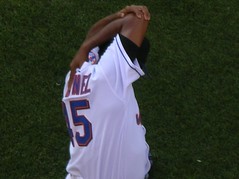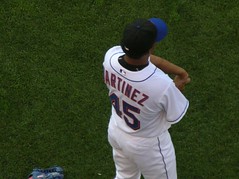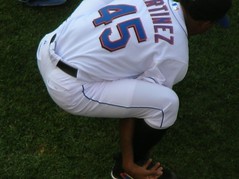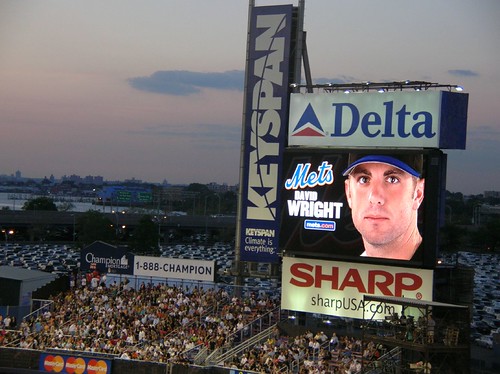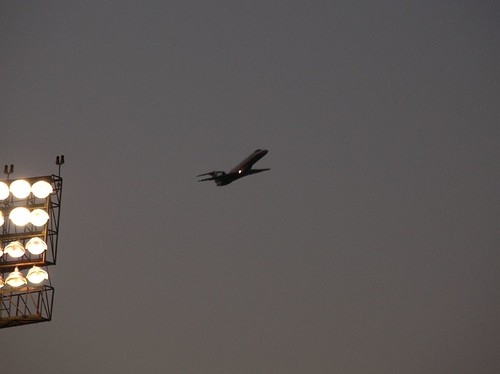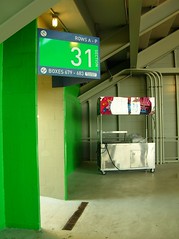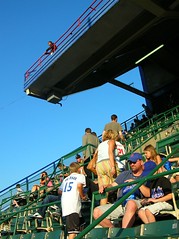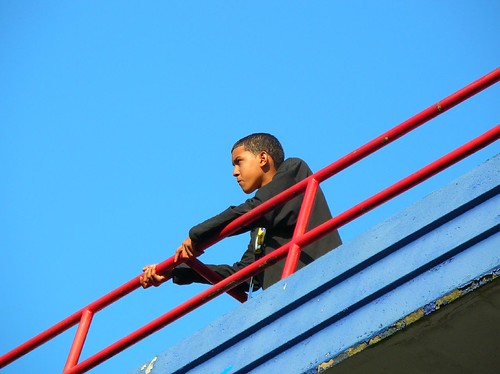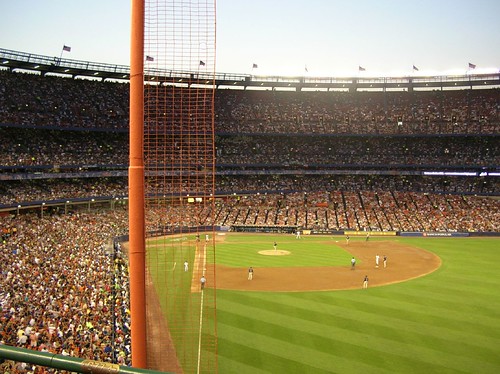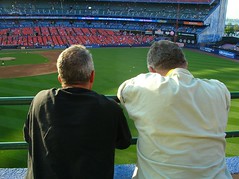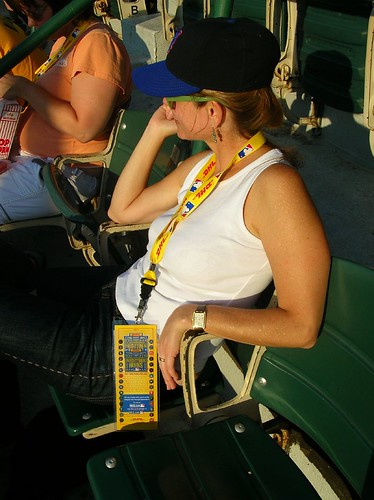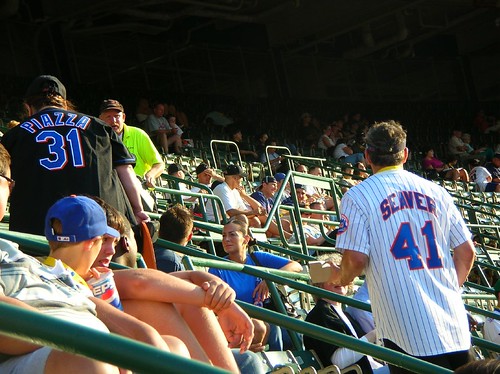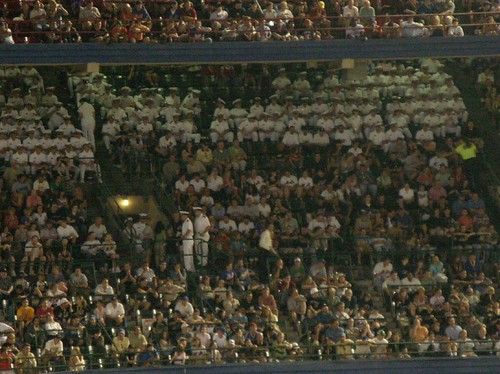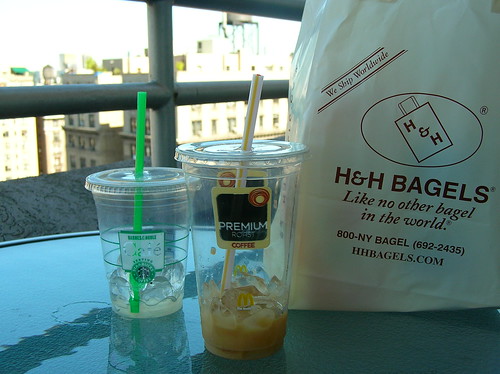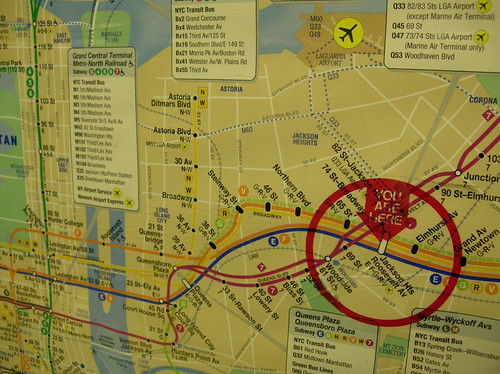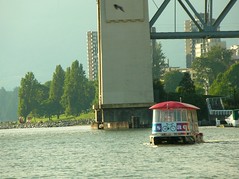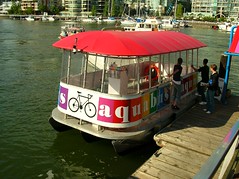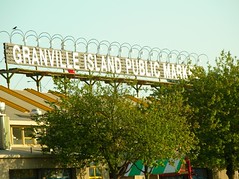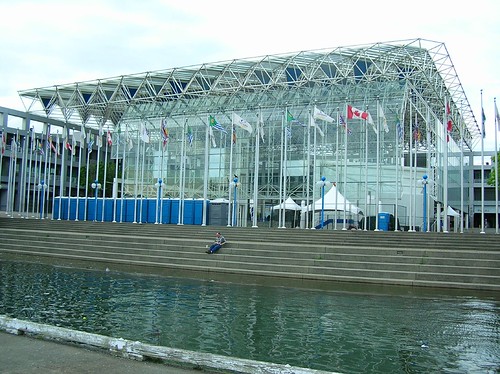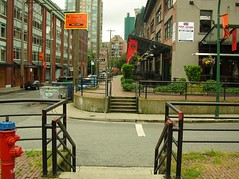Thursday, August 31, 2006
Carry on, make it work
Is Project Runway getting... boring?
It's hard to know whether it's the show or me, but in the two weeks following the wrong-headed elimination of Alison, it seems like the show's engines just suddenly conked out and it's just drifting.
Let's gather the facts. For the last four weeks, it has been a consistent Michael love fest: he either wins, or nearly wins, and he's so obviously talented and destined for the final three that they might as well just give him advanced placement. He's like the Mets wrapping up the division by August.
Uli and Laura are talented too, but the judges keep letting them get away with making the same things over and over. Their designs are getting boring.
Vincent, who started out as an obnoxious jerk who made consistently ugly stuff, has mellowed himself out into a soporiphic nebbish whose last two designs have been way too safe. This week he got by "designing" a charcoal v-neck pullover and baggy slacks, which he could easily have picked up at Target. That he survived the judging -- the challenge was to make a "jet set" outfit for the designer himself/herself -- shows a high tolerance for boring, despite last week's elimination of the aggressively dull Robert.
Kayne, too, is falling into a design rut: his stuff is becoming consistently tacky, as this week he made himself an Elvis costume for the "jet setting" challenge.
Jeffrey seemed more interesting after last week -- the momathon, in which the designers had to make outfits for their competitors' mostly fat moms or sisters -- when we learned that his mother loves him and that he is a recovering alcoholic and drug addict. But he's not that interesting, and his nasty little personality conflict with Angela -- this season's only conflict story line -- has dried out into an ordinary "co-worker from hell" humdrum.
And in any event, that's over, because they just kicked off Angela. You can't vehemently argue with the decision, since she's probably the least talented designer left other than Vincent. Angela has been making the same crap week after week -- always with the "rouching" and the florettes -- and the only question is whether the design challenge is one that lends itself to her style (in which case she does well) or not.
But that's the bigger problem. Last season, the challenges forced the contestants out of their comfort zones more regularly and systematically. This season, most of them have been doing their same thing week after week, and -- with the notable exception of Robert and the occasional reference to somebody's consistent style -- getting away with it in the judging.
Tim's signature line from last season "Make it work!" seems to have been adopted as a sort of official brand of the show. It's used in the promotional materials, and even Heidi has said it in commercial spots. Maybe that's way Tim has rolled out a new one for himself this season, "carry on!"
As he left the workroom after his weekly critique of the designs in progress, Tim deployed both catch phrases together: "Make it work! Carry on!" But he plainly lacked conviction: even this bit of fun seems to be growing threadbare.
It's hard to know whether it's the show or me, but in the two weeks following the wrong-headed elimination of Alison, it seems like the show's engines just suddenly conked out and it's just drifting.
Let's gather the facts. For the last four weeks, it has been a consistent Michael love fest: he either wins, or nearly wins, and he's so obviously talented and destined for the final three that they might as well just give him advanced placement. He's like the Mets wrapping up the division by August.
Uli and Laura are talented too, but the judges keep letting them get away with making the same things over and over. Their designs are getting boring.
Vincent, who started out as an obnoxious jerk who made consistently ugly stuff, has mellowed himself out into a soporiphic nebbish whose last two designs have been way too safe. This week he got by "designing" a charcoal v-neck pullover and baggy slacks, which he could easily have picked up at Target. That he survived the judging -- the challenge was to make a "jet set" outfit for the designer himself/herself -- shows a high tolerance for boring, despite last week's elimination of the aggressively dull Robert.
Kayne, too, is falling into a design rut: his stuff is becoming consistently tacky, as this week he made himself an Elvis costume for the "jet setting" challenge.
Jeffrey seemed more interesting after last week -- the momathon, in which the designers had to make outfits for their competitors' mostly fat moms or sisters -- when we learned that his mother loves him and that he is a recovering alcoholic and drug addict. But he's not that interesting, and his nasty little personality conflict with Angela -- this season's only conflict story line -- has dried out into an ordinary "co-worker from hell" humdrum.
And in any event, that's over, because they just kicked off Angela. You can't vehemently argue with the decision, since she's probably the least talented designer left other than Vincent. Angela has been making the same crap week after week -- always with the "rouching" and the florettes -- and the only question is whether the design challenge is one that lends itself to her style (in which case she does well) or not.
But that's the bigger problem. Last season, the challenges forced the contestants out of their comfort zones more regularly and systematically. This season, most of them have been doing their same thing week after week, and -- with the notable exception of Robert and the occasional reference to somebody's consistent style -- getting away with it in the judging.
Tim's signature line from last season "Make it work!" seems to have been adopted as a sort of official brand of the show. It's used in the promotional materials, and even Heidi has said it in commercial spots. Maybe that's way Tim has rolled out a new one for himself this season, "carry on!"
As he left the workroom after his weekly critique of the designs in progress, Tim deployed both catch phrases together: "Make it work! Carry on!" But he plainly lacked conviction: even this bit of fun seems to be growing threadbare.
Tuesday, August 29, 2006
Headline: "Bush Remembers Katrina Victims"
Yeah... that hurricaine, right? I seem to recall something about that myself.
We don't get no respect
I find it extremely irritating how the sports pundits, like the entire ESPN broadcast team, treat the Mets like a boring non story: loaded with high priced talent, the Mets were always supposed to win. They've chosen to forget that, at the start of the season, they picked the Braves to win the division again, with the Mets finishing third behind the Phillies. And that they had gleefully plotted out a story line about the Mets: big payroll, big disappointment.
Okay, so "we were wrong" is something broadcasters don't like to say. But they take their refusal to eat crow a step further with their studied indifference.
These days they're all:
"Oh, the Mets, they're in the post season already. Ho, hum. Now, how about those Phillies! 20-12 since they traded Bobby Abreu!!"
Of course, the Mets are 21-11 in the same time frame, with a starting staff consisting of Steve Trachsel, el Duque and the minor league cast-offs. The Mets, who have had more key injuries then about anybody, have the second best record in baseball, a mere 1 game behind the "phenomenal" Detroit Tigers.
No matter -- living well is the best revenge.
Okay, so "we were wrong" is something broadcasters don't like to say. But they take their refusal to eat crow a step further with their studied indifference.
These days they're all:
"Oh, the Mets, they're in the post season already. Ho, hum. Now, how about those Phillies! 20-12 since they traded Bobby Abreu!!"
Of course, the Mets are 21-11 in the same time frame, with a starting staff consisting of Steve Trachsel, el Duque and the minor league cast-offs. The Mets, who have had more key injuries then about anybody, have the second best record in baseball, a mere 1 game behind the "phenomenal" Detroit Tigers.
No matter -- living well is the best revenge.
Monday, August 28, 2006
When cleverness goes bad
I've subscribed (at great personal expense, I might add) to the cable TV baseball package, which enables me to see the majority of New York Mets games on SNY, the New York area sports cable station. SNY also covers the other New York sports teams, including the football New York Jets.
There is a long tradition in this country dating back to the late 19th century, of sportswriting that is self-consciously grandiloquent, excessively cutesy, ironically pseudo-poetical, etc. Think "Casey at the Bat," Ring Lardner. Think calling a catcher a "backstop" or referring to the pitcher putting his foot on the pitching rubber as "toeing the slab." Think of the nickname "gridiron" for football field. You get the idea -- and it continues to this day.
Combine that with marketing to a demographic of heavy beer drinkers who chortle at Miller Light commercials, and you get the following nickname for the Jets, whose colors are green and white:
There is a long tradition in this country dating back to the late 19th century, of sportswriting that is self-consciously grandiloquent, excessively cutesy, ironically pseudo-poetical, etc. Think "Casey at the Bat," Ring Lardner. Think calling a catcher a "backstop" or referring to the pitcher putting his foot on the pitching rubber as "toeing the slab." Think of the nickname "gridiron" for football field. You get the idea -- and it continues to this day.
Combine that with marketing to a demographic of heavy beer drinkers who chortle at Miller Light commercials, and you get the following nickname for the Jets, whose colors are green and white:
"Gang Green."Is it just me, or did they go a bit astray with that one? I have a few alternative suggestions:
Running Sore.
Intestinal Blockage.
Steaming Pile.
Passing Gas.
Sunday, August 27, 2006
Collective nouns: a beard of ants
According to this "Fun with words: collective nouns" page:
So let's belatedly take up Neels' invitation to make a game of making up our own. Word Daze tried to get this started some time ago, and Neel rose to the challenge with "a matlock of senior citizens."
My offer of "a beard of ants" is inspired by this recent scene in my driveway.
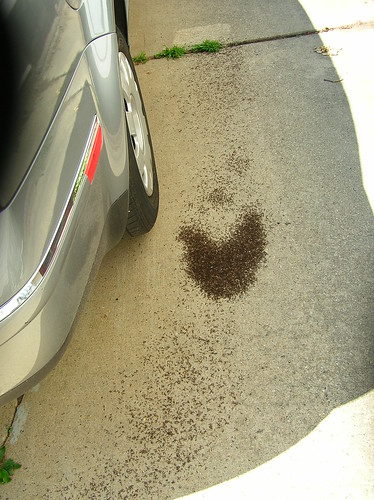
One of the craziest oddities of the English language is that there are so many different collective nouns that all mean "group" but which are specific to what particular thing there is a group of: a herd of elephants, a crowd of people, a box of crayons, a pad of paper, etc. There is great diversity of collective nouns associated with animals, from a sleuth of bears to a murder of crows.Crazy! And odd! But when you study that list, you wonder whether there's some etymological structure behind this, or whether it's just linguistic happenstance (a fancy way of saying "people making sh*t up"). Why, for instance, do you have a "hive of bees" but not a "nest of ants"? (This list says "colony" of ants.) Do some of these terms make "the list" simply by reaching a critical mass of usage?
So let's belatedly take up Neels' invitation to make a game of making up our own. Word Daze tried to get this started some time ago, and Neel rose to the challenge with "a matlock of senior citizens."
My offer of "a beard of ants" is inspired by this recent scene in my driveway.

Saturday, August 26, 2006
I almost forgot to mention
... this little detail rounding out my story of cell phone madness.
As I was fumbling to get my camera out of my backpack and snap a photo of the cell-phone talker driving the massive construction vehicle one-handed, I was nearly sideswiped -- as I stood on the sidewalk, of course -- by her:

As I was fumbling to get my camera out of my backpack and snap a photo of the cell-phone talker driving the massive construction vehicle one-handed, I was nearly sideswiped -- as I stood on the sidewalk, of course -- by her:

Friday, August 25, 2006
Existential Friday: can you be so successful that you simply disappear?
Mr. Verb reports here that Google has pressured a leading German dictionary to delete an entry defining "to google" as a generic term meaning to look up on the internet.
Why do people say "google it" when they mean "look it up on a web browser"? Because Google is the dominant web browser. It's a good product/service, and it's a fun and easy word to say. Much better than "ask-dot-com-it" or "metacrawlit."
So why would Google fight getting such a nice tribute in a dictionary?
Apparently, a brand name can lose trademark protection if it becomes a generic word. Talk about being hoist on the petard of your own success!
But Google is being pretty dumb here. The appearance of the verb "to google" in the dictionary is not what makes the word generic. That's simply one form of evidence of language usage. The real proof is in the spoken language itself -- the millions of conversations of ordinary people. And you can prove that without a dictionary. Is Google going to sue all of us to stop us from saying "google it"?
As Mr. Verb himself would say, "language changes -- deal with it!"
* * *
Hey, wait a minute... links to Mr. Verb??? That's right! Columnist Manifesto commenter extraordinaire Mr. Verb has taken his act and started his own blog! Check it out.
Again, that's Verb... Mr. Verb.
Why do people say "google it" when they mean "look it up on a web browser"? Because Google is the dominant web browser. It's a good product/service, and it's a fun and easy word to say. Much better than "ask-dot-com-it" or "metacrawlit."
So why would Google fight getting such a nice tribute in a dictionary?
Apparently, a brand name can lose trademark protection if it becomes a generic word. Talk about being hoist on the petard of your own success!
But Google is being pretty dumb here. The appearance of the verb "to google" in the dictionary is not what makes the word generic. That's simply one form of evidence of language usage. The real proof is in the spoken language itself -- the millions of conversations of ordinary people. And you can prove that without a dictionary. Is Google going to sue all of us to stop us from saying "google it"?
As Mr. Verb himself would say, "language changes -- deal with it!"
* * *
Hey, wait a minute... links to Mr. Verb??? That's right! Columnist Manifesto commenter extraordinaire Mr. Verb has taken his act and started his own blog! Check it out.
Again, that's Verb... Mr. Verb.
Thursday, August 24, 2006
On the cell phone while driving

Isn't this taking a good joke too far? In this picture, he's stopped the vehicle, but a few seconds before, this guy was driving that thing on the construction site along the edge of a busy street, using one hand while holding his cell phone with the other.
In this next picture, he's driven back into the excavation pit, which obscures the massive tank treads. But it gives you some idea of the vehicle's size. And, to be clear, moments earlier, while I fumbled to get my camera out, he was driving that one handed on the sidewalk.

When are we going to stop to the madness?
Tuesday, August 22, 2006
War and the sons of the rich
I'm reading Flyboys: A True Story of Courage, by James Bradley.*
Bradley interviewed several World War II pilots, including George H.W. Bush. According to Bush, the guest speaker for Bush's graduation ceremony at the exclusive prep school, Phillips Andover Academy, in spring 1942 was Secretary of War Henry Stimson.
As impressive as it is to get the Secretary of War to take time out to be your high school graduation speaker during a major war, that was nothing compared to what Stimson actually said.
Stimson, himself the scion of a wealthy family and himself a graduate of Phillips Andover Academy, told the 17- and18-year-olds in the graduating class that they should complete their educations rather than enlisting in the armed forces. That would help their country more.
That's right. The Secretary of War, just a few months after Pearl Harbor, told this privileged group of 17- and 18- year olds not to join up. Meanwhile, the War department was recruiting 17 and 18 year olds like mad to fill out the manpower needs of a nation at war, a nation whose pre-war armed forces were something like the 18th largest in the world in terms of manpower.
Bush's father Prescott also did not want his son to enlist. To his great credit, however, Bush override the advice of Stimson and the wishes of his father; he enlisted and became a Navy pilot.
___
*This is an account of a secret mission in the Pacific in WWII, not to be confused with the new major motion picture "Flyboys," about the Lafayette Escadrille in WWI.
Bradley interviewed several World War II pilots, including George H.W. Bush. According to Bush, the guest speaker for Bush's graduation ceremony at the exclusive prep school, Phillips Andover Academy, in spring 1942 was Secretary of War Henry Stimson.
As impressive as it is to get the Secretary of War to take time out to be your high school graduation speaker during a major war, that was nothing compared to what Stimson actually said.
Stimson, himself the scion of a wealthy family and himself a graduate of Phillips Andover Academy, told the 17- and18-year-olds in the graduating class that they should complete their educations rather than enlisting in the armed forces. That would help their country more.
That's right. The Secretary of War, just a few months after Pearl Harbor, told this privileged group of 17- and 18- year olds not to join up. Meanwhile, the War department was recruiting 17 and 18 year olds like mad to fill out the manpower needs of a nation at war, a nation whose pre-war armed forces were something like the 18th largest in the world in terms of manpower.
Bush's father Prescott also did not want his son to enlist. To his great credit, however, Bush override the advice of Stimson and the wishes of his father; he enlisted and became a Navy pilot.
___
*This is an account of a secret mission in the Pacific in WWII, not to be confused with the new major motion picture "Flyboys," about the Lafayette Escadrille in WWI.
Monday, August 21, 2006
Am I missing something?
In the commentary on the "Luther Burger" (bacon cheeseburger on a Krispy Kreme bun) -- both on this blog and in cyberspace generally -- there is a widespread assumption that eating this thing is self-destructive if not suicidal.
Maybe it is. But is it more suicidal than eating a bacon cheeseburger on a white bread bun followed by a Krispy Kreme donut for dessert? I mean, is there something about the hamburger patty sitting on the donut -- or perhaps re-heating the donut -- that causes a synergistic mega-release of fat?
Unless I'm missing something, the cheeseburger plus the donut has to be worse than the cheeseburger on the donut, which at least cuts out the white bread.
So how come, when cheeseburgers are discussed, you don't here people say: "well, eat that if you must, but whatever you do, don't follow it up with a Krispy Kreme for dessert! That is if you want to live to see the sun rise."
Maybe it is. But is it more suicidal than eating a bacon cheeseburger on a white bread bun followed by a Krispy Kreme donut for dessert? I mean, is there something about the hamburger patty sitting on the donut -- or perhaps re-heating the donut -- that causes a synergistic mega-release of fat?
Unless I'm missing something, the cheeseburger plus the donut has to be worse than the cheeseburger on the donut, which at least cuts out the white bread.
So how come, when cheeseburgers are discussed, you don't here people say: "well, eat that if you must, but whatever you do, don't follow it up with a Krispy Kreme for dessert! That is if you want to live to see the sun rise."
Sunday, August 20, 2006
Did somebody mention donuts?
 I last saw my beloved coffee mug at the sink next to the coffee machine at work; I mistakenly left it there, and it vanished. It had a cartoon of a pile of donuts -- they looked positively cuddly -- with the caption: "Did somebody mention donuts?"
I last saw my beloved coffee mug at the sink next to the coffee machine at work; I mistakenly left it there, and it vanished. It had a cartoon of a pile of donuts -- they looked positively cuddly -- with the caption: "Did somebody mention donuts?"Janelle mentioned donuts on Friday. Well, sort of. Meanwhile, many miles away, I was stopping at my favorite donut shop just as they were putting out a fresh batch of glazed raised donuts. You know -- the kind everyone thinks of when they think of Krispy Kreme.
I realized two things as I bit into this donut. First, I would immediately have to order two more. Second, the difference between this donut when hot and fresh versus this donut when at room temperature is like the difference between hot buttered toast and cool, congealed-buttered toast.
Words can't express the experience of eating this perfect donut. It had a melted-buttery taste, the most exquisite hint of crispiness mixed in with the expected soft doughiness, and it smelled like just-out-of-the-oven bread.
And the weird thing is: it made me want to slice it in half, bagelwise, and put a cheeseburger between the two halves. And eat it of course.
Yes, for the first time I understood what it means to want the "Luther Burger," a/k/a "Baseball's Best Burger," a/k/a "World's Unhealthiest Burger."*
____
*The latter link, to the CBS news story, has a photo making the burger look like a medical procedure rather than a food item. I suppose that was intentional.
Saturday, August 19, 2006
The case against Shawn Green
I have nothing against Shawn Green. My "case" is that the Mets should not acquire him. I hope their rumored interest is bogus and that Omar Minaya is too smart for that.
Clearly manager Willie Randolph is. He's told reporters about the outfield "if it ain't broke, don't fix it." I read that as code for "Shawn Green isn't going to provide more offensive production than we're already going to get from the revolving combination of Michael Tucker, Endy Chavez and Lastings Milledge."
Green is pushing 34 years old, and is on a dramatic decline in his offensive production. A former power hitter, he's on pace to hit 3 or 4 more home runs this year for a total of 13 or 14. Yet he's earning something like 11 million dollars this year, and is owed $9.5 million next year and something comparable in 2008, though he can be dumped by paying a $2 million buyout.
That Green is even being considered is a result of the distorted picture of player performance created by steroids. Would any general manager, before the improbable careers of Mcgwire, Palmiero, and Bonds, have been dumb enough to suppose that a 33 1/2 year-old slugger with 28, 22 and 10 home runs in the past 2 and 2/3 seasons is going to bounce back and hit 25+ homers? Well, yes, but only the dumbest ones.
Shea Stadium -- a pitcher's park with nastily demanding fans and the infamous New York media crush -- is really not the place for overaged, declining hitters like Green to regain their former glory. It's where they come to die.
The Mets have a long, sorry history of signing sluggers over the age of 32 who joined the team, performed disappointingly and just took up space: Dave Kingman, George Foster, Mo Vaughn, to name the most recent.
And we've already got Carlos Delgado. Delgado has helped the team tremendously, putting up great numbers for the first half a season and contributing to the great clubhouse chemistry. He's a charming, intelligent man who gives the impression of a wise soul. So I really hate to say that he has probably become a drain in the cleanup spot. He's no longer producing, but they have to keep batting him fourth for reasons of personality and clubhouse diplomacy.
The only incentive to get Green is to help the team out of a jam for less than half a season and the post season -- assuming Cliff Floyd can't return. But Green really won't help more than the Chavez-Tucker-Milledge trio this season, and his big salary for next year will put undue pressure on Randolph to give him playing time, and stand in the way of acquiring an outfielder who's better.
Clearly manager Willie Randolph is. He's told reporters about the outfield "if it ain't broke, don't fix it." I read that as code for "Shawn Green isn't going to provide more offensive production than we're already going to get from the revolving combination of Michael Tucker, Endy Chavez and Lastings Milledge."
Green is pushing 34 years old, and is on a dramatic decline in his offensive production. A former power hitter, he's on pace to hit 3 or 4 more home runs this year for a total of 13 or 14. Yet he's earning something like 11 million dollars this year, and is owed $9.5 million next year and something comparable in 2008, though he can be dumped by paying a $2 million buyout.
That Green is even being considered is a result of the distorted picture of player performance created by steroids. Would any general manager, before the improbable careers of Mcgwire, Palmiero, and Bonds, have been dumb enough to suppose that a 33 1/2 year-old slugger with 28, 22 and 10 home runs in the past 2 and 2/3 seasons is going to bounce back and hit 25+ homers? Well, yes, but only the dumbest ones.
Shea Stadium -- a pitcher's park with nastily demanding fans and the infamous New York media crush -- is really not the place for overaged, declining hitters like Green to regain their former glory. It's where they come to die.
The Mets have a long, sorry history of signing sluggers over the age of 32 who joined the team, performed disappointingly and just took up space: Dave Kingman, George Foster, Mo Vaughn, to name the most recent.
And we've already got Carlos Delgado. Delgado has helped the team tremendously, putting up great numbers for the first half a season and contributing to the great clubhouse chemistry. He's a charming, intelligent man who gives the impression of a wise soul. So I really hate to say that he has probably become a drain in the cleanup spot. He's no longer producing, but they have to keep batting him fourth for reasons of personality and clubhouse diplomacy.
The only incentive to get Green is to help the team out of a jam for less than half a season and the post season -- assuming Cliff Floyd can't return. But Green really won't help more than the Chavez-Tucker-Milledge trio this season, and his big salary for next year will put undue pressure on Randolph to give him playing time, and stand in the way of acquiring an outfielder who's better.
iMegalomania
Janelle asks a good question: "Why did Apple name its email program simply Mail? Why not iMail?"
Maybe they've started to worry (justifiably) that they've painted themselves in a corner with their branding gimmick of the lower case "i" in front of everything; that it's starting to sound like a sort of high-tech pig Latin.
But calling its email program Mail has a hegemonic Microsoft quality about it. They want to brand the word "mail," so that their product becomes the standard word for the genre, like "coke" or "kleenex" or "xerox." Only, the word "mail" is not their creation -- it was our word. They're trying to take over our word.
If Apple wins this particular battle for our hearts and minds, we will all have to use awkward, insulting phrases like "snail mail" or "postal mail" or "traditional paper mail" for the stuff that the letter carriers bring us in their mail sacks. I don't want to be pushed in that direction. Mail (not iMail, dammit!), is still pretty darn useful. And believe it or not, it's less prone to hacking.
This just confirms, again, my suspicion that Apple is basically Microsoft with a smaller market share. They'd try to rule the world if they could.
Maybe they've started to worry (justifiably) that they've painted themselves in a corner with their branding gimmick of the lower case "i" in front of everything; that it's starting to sound like a sort of high-tech pig Latin.
But calling its email program Mail has a hegemonic Microsoft quality about it. They want to brand the word "mail," so that their product becomes the standard word for the genre, like "coke" or "kleenex" or "xerox." Only, the word "mail" is not their creation -- it was our word. They're trying to take over our word.
If Apple wins this particular battle for our hearts and minds, we will all have to use awkward, insulting phrases like "snail mail" or "postal mail" or "traditional paper mail" for the stuff that the letter carriers bring us in their mail sacks. I don't want to be pushed in that direction. Mail (not iMail, dammit!), is still pretty darn useful. And believe it or not, it's less prone to hacking.
This just confirms, again, my suspicion that Apple is basically Microsoft with a smaller market share. They'd try to rule the world if they could.
Friday, August 18, 2006
Existential Friday: just another zero sum game
A doff of the cap to Neel Mehta for his sweet obituary about Bruno Kirby, the character actor whose best-known role was that of Billy Crystal's sidekick in When Harry Met Sally. Neel reminds us of Kirby's best scene, where his new fiancee Carrie Fisher is throwing out the tasteless junk from Kirby's formerly bachelor apartment; the big conflict occurs over his wagon-wheel coffee table, and generates my favorite line from the film.
I'm just glad I'm one of the ones with good taste.**
____
*According to web-based sources, the actual quote is: "Everybody thinks they have good taste and a sense of humor, but they couldn't possibly all have good taste." I think my version is snappier.
**What, you want proof? How about my decision to remove thebutt crack photo from this blog?
Marie [Carrie Fisher]: Everybody thinks they have good taste and a great sense of humor. But that can't possibly be true, can it?*Who would have thought that such abstract personal characteristics -- culturally- determined ones, to be sure -- would be a zero sum game? But it's just as true as the fact that not everybody can be tall. For some people to have good taste, or be funny, there have to be others who aren't.
I'm just glad I'm one of the ones with good taste.**
____
*According to web-based sources, the actual quote is: "Everybody thinks they have good taste and a sense of humor, but they couldn't possibly all have good taste." I think my version is snappier.
**What, you want proof? How about my decision to remove thebutt crack photo from this blog?
Thursday, August 17, 2006
Project Runway's gender politics
This is a post about one of the many reasons why Project Runway is worth watching even if you're not (as I am not) a fashion bug.
I've always felt that straight men have been burdened with a disproportionate share of the blame for the "woman's body image" problem: it's all, or mostly, straight men's fault that women get breast implants or starve themselves into thinness.
I'm not saying straight men are blameless. But when the book is finally written on this subject (for all I know it has been... I don't read the stuff), a major culprit will, of course, be the women's fashion industry itself.
The women's fashion industry is gay guys designing for women who want to impress other women. There are no straight guys in that fundamental equation. Even if that's a stereotype, it doesn't mean there isn't a lot of truth in it.
Of course we don't actually know who's gay and who's straight on Project Runway, but we probably assume (okay, I do) that most of the male designers and professionals on the show are gay. But taking that stereotyping assumption as a starting point, Project Runway shows week-in week-out something we all should have known all along, but that some of us realize more slowly than others, that gay male personalities come in all shapes and sizes.
Having said that, there is plenty of stereotypical fashion queen stuff going on in the show. Kayne (loves beauty pageants and Marilyn) and Robert (works for Mattel designing clothes for Barbi) are this season's stereotypical designing fags, and they live up to the part by showing us fits of misogyny. We see them starting to fixate on Laura, a strong personality who's giving them stiff competition, as some sort of demon-lady, and they dish Kayne's model as though she was merely some sort of goofy mannequin.
Michael Kors plays the role of bitchy fashion judge to the hilt. Kors was a key figure in this week's judging decision where, for the first time I really noticed it, sexism came up through the cracks like a big ugly weed.
Of the three designers who bombed this week, Kayne got a pass based on the quality of his prior designs: "but he really knows how to make clothes," said Kors, saving him from elimination. The judges -- Kors and three women (Heidi, Nina Garcia and a guest judge) -- decided to eliminate the talented Alison rather than the clownish, consistently bad Vincent, because (as I point out in the prior post here) they thought Alison's design made her model look fat. Unlike Kayne, Alison did not get the benefit of her past record of good designs.
During the judging, Kors kept harping on how shocking it was that Alison, "as a woman," would commit that error. The women judges, particularly Heidi, definitely hated a design that fattened the model, but Kors really seemed to be the alpha judge on this issue.
In a sex discrimination lawsuit, the telltale phrase "as a woman" would -- rightly -- be considered smoking gun evidence of a discriminatory double-standard. That, along with the differential treatment of her and Kayne -- he got credit for his past good work, she didn't -- and you have a case I would readily take to trial.
And speaking of stereotypes and sexism relating to the judging, the weekly cell-phone poll during the show asked, this week, which of the three regular judges was "the toughest." And by a 3-1 margin, the viewers picked Nina Garcia over Michael Kors. But there's no way that's true. The two of them are indistinguishable in the harshness of their judgment, and if anything, Kors should superficially look harsher given his penchant for the cat-scratching bon mot ("it looks like a wrinkled dinner napkin!"). It's pure sexual stereotyping -- Nina looks mean compared, not with Michael, but with the expectation that women should be kinder.*
Anyway, for me, this latest Project Runway episode provides a fascinating glimpse into how misogynistic gay fashion designers play a part in women's body image. And this is only the tip of the iceberg of the gender politics (not just male-female, but also gay-straight) that swirl around in this fascinating show. One day, doctoral dissertations will be written about this show. Maybe they're being written now.
______
*All of this is subject to the caveat that maybe, like Jessica Rabbit, "they can't help it, they're just drawn [ -- in this case, edited --] that way." (Is Tim Gunn really such a charming mensh, or does he just play one on TV? There's a studied quality to his charm: this year he keeps rotely telling the eliminated constestants "we're going to miss you," as if focus groups told the show's producers that the old "you have to clean up your workspace now" was too cold. )
______
UPDATE: A commenter on Althouse, who links to this post, says:
I've always felt that straight men have been burdened with a disproportionate share of the blame for the "woman's body image" problem: it's all, or mostly, straight men's fault that women get breast implants or starve themselves into thinness.
I'm not saying straight men are blameless. But when the book is finally written on this subject (for all I know it has been... I don't read the stuff), a major culprit will, of course, be the women's fashion industry itself.
The women's fashion industry is gay guys designing for women who want to impress other women. There are no straight guys in that fundamental equation. Even if that's a stereotype, it doesn't mean there isn't a lot of truth in it.
Of course we don't actually know who's gay and who's straight on Project Runway, but we probably assume (okay, I do) that most of the male designers and professionals on the show are gay. But taking that stereotyping assumption as a starting point, Project Runway shows week-in week-out something we all should have known all along, but that some of us realize more slowly than others, that gay male personalities come in all shapes and sizes.
Having said that, there is plenty of stereotypical fashion queen stuff going on in the show. Kayne (loves beauty pageants and Marilyn) and Robert (works for Mattel designing clothes for Barbi) are this season's stereotypical designing fags, and they live up to the part by showing us fits of misogyny. We see them starting to fixate on Laura, a strong personality who's giving them stiff competition, as some sort of demon-lady, and they dish Kayne's model as though she was merely some sort of goofy mannequin.
Michael Kors plays the role of bitchy fashion judge to the hilt. Kors was a key figure in this week's judging decision where, for the first time I really noticed it, sexism came up through the cracks like a big ugly weed.
Of the three designers who bombed this week, Kayne got a pass based on the quality of his prior designs: "but he really knows how to make clothes," said Kors, saving him from elimination. The judges -- Kors and three women (Heidi, Nina Garcia and a guest judge) -- decided to eliminate the talented Alison rather than the clownish, consistently bad Vincent, because (as I point out in the prior post here) they thought Alison's design made her model look fat. Unlike Kayne, Alison did not get the benefit of her past record of good designs.
During the judging, Kors kept harping on how shocking it was that Alison, "as a woman," would commit that error. The women judges, particularly Heidi, definitely hated a design that fattened the model, but Kors really seemed to be the alpha judge on this issue.
In a sex discrimination lawsuit, the telltale phrase "as a woman" would -- rightly -- be considered smoking gun evidence of a discriminatory double-standard. That, along with the differential treatment of her and Kayne -- he got credit for his past good work, she didn't -- and you have a case I would readily take to trial.
And speaking of stereotypes and sexism relating to the judging, the weekly cell-phone poll during the show asked, this week, which of the three regular judges was "the toughest." And by a 3-1 margin, the viewers picked Nina Garcia over Michael Kors. But there's no way that's true. The two of them are indistinguishable in the harshness of their judgment, and if anything, Kors should superficially look harsher given his penchant for the cat-scratching bon mot ("it looks like a wrinkled dinner napkin!"). It's pure sexual stereotyping -- Nina looks mean compared, not with Michael, but with the expectation that women should be kinder.*
Anyway, for me, this latest Project Runway episode provides a fascinating glimpse into how misogynistic gay fashion designers play a part in women's body image. And this is only the tip of the iceberg of the gender politics (not just male-female, but also gay-straight) that swirl around in this fascinating show. One day, doctoral dissertations will be written about this show. Maybe they're being written now.
______
*All of this is subject to the caveat that maybe, like Jessica Rabbit, "they can't help it, they're just drawn [ -- in this case, edited --] that way." (Is Tim Gunn really such a charming mensh, or does he just play one on TV? There's a studied quality to his charm: this year he keeps rotely telling the eliminated constestants "we're going to miss you," as if focus groups told the show's producers that the old "you have to clean up your workspace now" was too cold. )
______
UPDATE: A commenter on Althouse, who links to this post, says:
The straight Jeffrey is also a classic misogynist. The quack comment last week and the feminazi (feminazi!) comment before.Sounds right to me that he's no respecter of women. And he's emerging as this season's biggest jerk -- him and his tattooed neck.
The capital offense on Project Runway
I can't believe they booted Alison from Episode 5 of Project Runway. For the first four weeks, she made consistently good designs, and she screwed up for the first and only time in this week's bizarro challenge where they had to make dresses out of recycled garbage.
Vincent showed us his endearing side in the first episode: required to work as a team with Angela, he basically refused to speak to her or let her touch his design, and then blamed her when the judges (rightly) trashed it. His designs are always bad and have been picked as one of the three worst by the judges in each of the five episodes. And he always says how great they are! He's either a stubborn BS artist or mildly delusional. And he's not even a fun character to watch on the show. How many more pieces of ugly crap do we have to see from him before they get rid of him?
So why did they ding Alison rather than Vincent, whose dress looked like a rolled up piece of paper with little scraps of paper clinging to it? Basically, the judges thought Allison's garment made her model look fat. This is the equivalent of an automatic elimination on Project Runway. You knew it was over for Alison when Heidi said, "Would I rather wear something ugly that is long and thin, or something that makes me look fat?"
Vincent showed us his endearing side in the first episode: required to work as a team with Angela, he basically refused to speak to her or let her touch his design, and then blamed her when the judges (rightly) trashed it. His designs are always bad and have been picked as one of the three worst by the judges in each of the five episodes. And he always says how great they are! He's either a stubborn BS artist or mildly delusional. And he's not even a fun character to watch on the show. How many more pieces of ugly crap do we have to see from him before they get rid of him?
So why did they ding Alison rather than Vincent, whose dress looked like a rolled up piece of paper with little scraps of paper clinging to it? Basically, the judges thought Allison's garment made her model look fat. This is the equivalent of an automatic elimination on Project Runway. You knew it was over for Alison when Heidi said, "Would I rather wear something ugly that is long and thin, or something that makes me look fat?"
Wednesday, August 16, 2006
Random milestone
Today, late afternoon or early evening, I expect to get the 100,000th hit to this blog. I suppose it's no more meaningful than the odometer reaching 100,000 miles, though it's sort of fun in the same way.
I'd like to offer the 100,000 visitor some sort of prize, but what if it's some random Google search? And what prize?
Maybe a dork tag?
UPDATE: Visitor #100,000 arrived at 8:17 p.m. All I know about this person is that he/she is in the UTC time zone, which I think is one zone west of California, and that he or she clicked over here from The Other Side of the Ocean. So unless he/she steps forward and self-identifies, the prize will have to go by default to Ocean's author, Nina.
I'd like to offer the 100,000 visitor some sort of prize, but what if it's some random Google search? And what prize?
Maybe a dork tag?
UPDATE: Visitor #100,000 arrived at 8:17 p.m. All I know about this person is that he/she is in the UTC time zone, which I think is one zone west of California, and that he or she clicked over here from The Other Side of the Ocean. So unless he/she steps forward and self-identifies, the prize will have to go by default to Ocean's author, Nina.
Tuesday, August 15, 2006
War of the worlds
I saw War of the Worlds last week on cable. Although I'd usually be up for a Spielberg sci-fi adventure, the Tom-Cruise-is-a-freak grossout factor had kept me from seeing it.
But Tom Cruise is also a good actor, and I got hooked in right away by the scene in which he plays catch with his teenage son in the backyard (I missed the first ten minutes or so). That scene, well acted on all hands and scripted with a funny, gritty emotional realism, looked like a family drama flick I'd have really wanted to see. So I guess it worked, because it motivated me to settle into the sci fi ride.
People who I've talked to about the movie have called it "gross" or "upsetting," both of which are true, but I came away thinking it's a fine film, the grossness not gratuitous. What Spielberg did was to create haunting images of what war and destruction would look like if visited on the soil of the continental United States -- something that really hasn't happened here since the 19th century.
As horrible as 9/11 was, it was a very localized disaster. Spielberg forced us to imagine widespread destruction of entire regions: buildings and houses levelled, infrastructure put out of action, human carnage, of course -- and refugees. Dazed people migrating in an instinctive but diretionless throng hoping to escape the danger.
Cruise himself gets in it his head that he has to take his kids to their mother -- his estranged wife -- up from New York to Boston. But why? There's no reason to think that Boston will be any safer. Just having a destination at all seems to be a strategy for survival.
And his losing battle to keep his 9-year old daughter from seeing traumatic things -- to the point where he blindfolds her -- is pathetic and heartwrenching. There's no way he can protect her from the traumatic events all around them -- and yet a little girl should not have to witness such things!
Spielberg's images come straight out of his lifetime studies of World War II. And he's telling us "it could happen here" -- not wrought by sci fi invaders from another planet, either. Maybe we in the United States will continue our blessed existence of safety from massive invasion. But it happens on this planet all the time. Children have, and continue to, witness this.
But Tom Cruise is also a good actor, and I got hooked in right away by the scene in which he plays catch with his teenage son in the backyard (I missed the first ten minutes or so). That scene, well acted on all hands and scripted with a funny, gritty emotional realism, looked like a family drama flick I'd have really wanted to see. So I guess it worked, because it motivated me to settle into the sci fi ride.
People who I've talked to about the movie have called it "gross" or "upsetting," both of which are true, but I came away thinking it's a fine film, the grossness not gratuitous. What Spielberg did was to create haunting images of what war and destruction would look like if visited on the soil of the continental United States -- something that really hasn't happened here since the 19th century.
As horrible as 9/11 was, it was a very localized disaster. Spielberg forced us to imagine widespread destruction of entire regions: buildings and houses levelled, infrastructure put out of action, human carnage, of course -- and refugees. Dazed people migrating in an instinctive but diretionless throng hoping to escape the danger.
Cruise himself gets in it his head that he has to take his kids to their mother -- his estranged wife -- up from New York to Boston. But why? There's no reason to think that Boston will be any safer. Just having a destination at all seems to be a strategy for survival.
And his losing battle to keep his 9-year old daughter from seeing traumatic things -- to the point where he blindfolds her -- is pathetic and heartwrenching. There's no way he can protect her from the traumatic events all around them -- and yet a little girl should not have to witness such things!
Spielberg's images come straight out of his lifetime studies of World War II. And he's telling us "it could happen here" -- not wrought by sci fi invaders from another planet, either. Maybe we in the United States will continue our blessed existence of safety from massive invasion. But it happens on this planet all the time. Children have, and continue to, witness this.
Monday, August 14, 2006
Public service announcement
You know me: I don't do this sort of thing (much), but today I'm making an exception. I thought yesterday's post on attending a Mets game was a particularly good one. It's funny, and you don't have to be a baseball fan to enjoy it. And it has some good photos.
Yet it garnered only two comments -- one of them from me!
Have you read it yet? Have you?
Yet it garnered only two comments -- one of them from me!
Have you read it yet? Have you?
Sunday, August 13, 2006
Dork Tag Day at Shea
[New York City, Wednesday, August 9]
Let me say, first of all, that I'm honored to spend $5 on a bottle of Snapple in order to help pay Carlos Beltran's salary
Let me also say that it was a beautiful, warm-but-not-too-hot summer evening, tailor made for baseball. Mets ace Pedro Martinez was on the mound, pitched a good game, and the Mets won, 4-3.
And B and I were lucky enough to be attending during the 3-game visit by the San Diego Padres. Piazza, who had been my favorite Met for the previous eight seasons, as he led the team to two League Championship Series and one World Series, parted ways with the Mets after last season and now plays for the Padres. And he's having a bit of a rebound year, bless him.
Anyway, a Mets fan necessarily holds his breath wondering whether his ornery Mets-fan colleagues will behave churlishly. This is group, after all, that will mercilessly boo its star players for each and every screwup, no matter how they performed before. I'm sad to say that Mets fans are among the league's nastiest. Would they boo Piazza in the foreign uniform?
As it turns out, everybody was just verklempt. On the first night, Piazza was given a fitting tribute: standing ovations, chants of his name, fans holding signs saying things like "we miss you Mike." There was even a Piazza highlight reel on the Diamondvision. On this night, we turned it into a sort of impromptu "Mike Piazza" night. Again, the standing o's. And this time, he hit a home run in his second at bat. And got a standing o for that. And took a curtain call.
A visiting player getting a standing ovation and taking a curtain call at Shea? It's unthinkable. But Piazza was that good as a Met. We owed him.
In his third at bat, he hit another home run. And got another standing ovation, and another curtain call. It was crazy.
Both home runs were solos -- the Padres only runs, in fact -- and the Mets were winning 4-2, so I guess we all felt we could be gracious. But when Piazza came up for the fourth time, with two runners on, and a chance to put the Padres in the lead with a home run, the fans had had enough. The boos predominated. And Piazza hit a gigantic blast to straightaway center field. Oy vey! Carlos Beltran reeled it in on the edge of the warning track -- the damn thing missed being a three run homer by about 3 feet.
Can you imagine a better game to see in person? Nothing could spoil it. And now for the list of things that didn't spoil it.
Let's start with the flyovers. Shea is famous for its proximity to Laguardia Airport and the fact that numerous flight plans go right over the stadium. You get about two jet flyovers per inning.
Not such a big deal -- you quickly get used to it.
The seats left something to be desired. I signed up for "best available" seats on line, but by the time I had entered my credit card information, they were gone. The next "best available" seats were all the way out in right field, second highest deck.
And then there was the small matter of the foul pole.
Next item: the two obnoxious guys sitting in front of us.
At Shea, you have to be prepared to be dissed by someone sitting in your vicinity, and these two obliged by making us feel stupid for having a bit of trouble finding our seats. I could have dealt with the rude behavior had it not been accompanied by this.
I think you know me well enough to know that I would not take a picture of someone's butt crack, let alone post it, unless there was good reason. But this was too much. [Editor's note: on the advice of persons with better taste and judgment than me, the photo of the actual butt crack in question has been removed.] I don't care how big a beer belly he has. He can pull his pants up. Or wear a shirt with shirttails -- tucked in our out, either would do the job. Or even wear boxers, for gosh sakes. There's really no excuse for this look in this day and age.
Then there was the promotion. I don't need to get free stuff at a ball game -- I expect to overpay for absolutely everything, and feel grateful that you're no longer expected to tip the ushers at Shea. But if you're going to have a promotional giveaway, how about something nice? In my life as a fan, I've gotten one or more of the following promotional giveaway items: baseball cap, plastic batting helmet, baseball bat, tote bag, photo, baseball, baseball with a photo on it, bobblehead, t-shirt.
But what is this? An ID card holder with DHL logo lanyard? A damned dork tag? This is not a promotion -- it's an insult.
To sum up: Tickets for two: $96. Italian sausages and drinks for two: $23. Seats behind foul pole: lousy. Flyovers: noisy. Butt crack: gross. Promotional dork tags: insulting. Seeing Mets eke out a win on Piazza Night: on the whole, worth it.
Let me say, first of all, that I'm honored to spend $5 on a bottle of Snapple in order to help pay Carlos Beltran's salary
Let me also say that it was a beautiful, warm-but-not-too-hot summer evening, tailor made for baseball. Mets ace Pedro Martinez was on the mound, pitched a good game, and the Mets won, 4-3.
Pedro Martinez doing his pre-game stretching routine.
I'm not exactly sure why he stretches his lower lip, though.
I'm not exactly sure why he stretches his lower lip, though.
And B and I were lucky enough to be attending during the 3-game visit by the San Diego Padres. Piazza, who had been my favorite Met for the previous eight seasons, as he led the team to two League Championship Series and one World Series, parted ways with the Mets after last season and now plays for the Padres. And he's having a bit of a rebound year, bless him.
Out with the old, in with our new favorite Met.
Anyway, a Mets fan necessarily holds his breath wondering whether his ornery Mets-fan colleagues will behave churlishly. This is group, after all, that will mercilessly boo its star players for each and every screwup, no matter how they performed before. I'm sad to say that Mets fans are among the league's nastiest. Would they boo Piazza in the foreign uniform?
As it turns out, everybody was just verklempt. On the first night, Piazza was given a fitting tribute: standing ovations, chants of his name, fans holding signs saying things like "we miss you Mike." There was even a Piazza highlight reel on the Diamondvision. On this night, we turned it into a sort of impromptu "Mike Piazza" night. Again, the standing o's. And this time, he hit a home run in his second at bat. And got a standing o for that. And took a curtain call.
A visiting player getting a standing ovation and taking a curtain call at Shea? It's unthinkable. But Piazza was that good as a Met. We owed him.
In his third at bat, he hit another home run. And got another standing ovation, and another curtain call. It was crazy.
Both home runs were solos -- the Padres only runs, in fact -- and the Mets were winning 4-2, so I guess we all felt we could be gracious. But when Piazza came up for the fourth time, with two runners on, and a chance to put the Padres in the lead with a home run, the fans had had enough. The boos predominated. And Piazza hit a gigantic blast to straightaway center field. Oy vey! Carlos Beltran reeled it in on the edge of the warning track -- the damn thing missed being a three run homer by about 3 feet.
Can you imagine a better game to see in person? Nothing could spoil it. And now for the list of things that didn't spoil it.
Let's start with the flyovers. Shea is famous for its proximity to Laguardia Airport and the fact that numerous flight plans go right over the stadium. You get about two jet flyovers per inning.
Not such a big deal -- you quickly get used to it.
The seats left something to be desired. I signed up for "best available" seats on line, but by the time I had entered my credit card information, they were gone. The next "best available" seats were all the way out in right field, second highest deck.
Our section: at the very end of the promenade. To our right, nothing but sky.
At least we weren't in the upper (nosebleed) deck. How lonely it is up there.
At least we weren't in the upper (nosebleed) deck. How lonely it is up there.
And then there was the small matter of the foul pole.
Best available seats. Well, there were almost 50,000 fans there.
Next item: the two obnoxious guys sitting in front of us.
At Shea, you have to be prepared to be dissed by someone sitting in your vicinity, and these two obliged by making us feel stupid for having a bit of trouble finding our seats. I could have dealt with the rude behavior had it not been accompanied by this.
I think you know me well enough to know that I would not take a picture of someone's butt crack, let alone post it, unless there was good reason. But this was too much. [Editor's note: on the advice of persons with better taste and judgment than me, the photo of the actual butt crack in question has been removed.] I don't care how big a beer belly he has. He can pull his pants up. Or wear a shirt with shirttails -- tucked in our out, either would do the job. Or even wear boxers, for gosh sakes. There's really no excuse for this look in this day and age.
Then there was the promotion. I don't need to get free stuff at a ball game -- I expect to overpay for absolutely everything, and feel grateful that you're no longer expected to tip the ushers at Shea. But if you're going to have a promotional giveaway, how about something nice? In my life as a fan, I've gotten one or more of the following promotional giveaway items: baseball cap, plastic batting helmet, baseball bat, tote bag, photo, baseball, baseball with a photo on it, bobblehead, t-shirt.
But what is this? An ID card holder with DHL logo lanyard? A damned dork tag? This is not a promotion -- it's an insult.
To sum up: Tickets for two: $96. Italian sausages and drinks for two: $23. Seats behind foul pole: lousy. Flyovers: noisy. Butt crack: gross. Promotional dork tags: insulting. Seeing Mets eke out a win on Piazza Night: on the whole, worth it.
A nice touch: at Shea, you can spot former Mets greats wandering the stands.
Here, Mike Piazza and Tom Seaver.
Here, Mike Piazza and Tom Seaver.
The crowd of nearly 50,000 included this contingent from the Navy, which stood and sang
a Navy song in unison after the game. I wish they had broadcast it on the PA system.
Oh, and these guys showed a lot of gusto doing "the wave." Really, they were into it.
a Navy song in unison after the game. I wish they had broadcast it on the PA system.
Oh, and these guys showed a lot of gusto doing "the wave." Really, they were into it.
Saturday, August 12, 2006
McD's suffers major setback in iced coffee war
That's right -- they've failed to win my business. I've made my third and final trip inside a McDonalds for iced coffee.
In New York, I figured I might well be within the McDonald's regional iced coffee experiment zone. (See here and here for background.) Sure enough, the upper west side McDonald's was offering what it called "premium" iced coffee. Significantly, not Newman's Own Organice Iced Coffee -- just a no-name "premium" blend.
"Premium" in the sense that word is used by the Ukrainian tour guide in Everything is Illuminated. Basically, it was not very good, just a watery and bland iced coffee.
But this visit re-confirmed the difference between McDonald's workers and "trained baristas." The following dialogue makes the point:
In New York, I figured I might well be within the McDonald's regional iced coffee experiment zone. (See here and here for background.) Sure enough, the upper west side McDonald's was offering what it called "premium" iced coffee. Significantly, not Newman's Own Organice Iced Coffee -- just a no-name "premium" blend.
Three stop breakfast shopping, upper west side, Manhattan: Starbucks iced latte for B,
"premium" McD's iced coffee for me, and H & H bagels.
"premium" McD's iced coffee for me, and H & H bagels.
"Premium" in the sense that word is used by the Ukrainian tour guide in Everything is Illuminated. Basically, it was not very good, just a watery and bland iced coffee.
But this visit re-confirmed the difference between McDonald's workers and "trained baristas." The following dialogue makes the point:
Me: Can I have an iced coffee, with cream, no sugar please?McD 1 picks up a paper, i.e., hot coffee, cup.
McD 1: What size?
Me: Medium.
Me: Iced coffee please.McD 2 does a sequence of assembly line type gestures and hands me a creamy iced coffee. I take a test sip before leaving the counter, and it's loaded with sugar.
McD 1 (picking up plastic cup): Vanilla or regular?
Me: Regular. With cream, but no sugar, please.
McD 1 to McD 2: He wants a medium regular iced coffee.
Me: With cream but no sugar please.
Me: Can I please have one of these with no sugar?From my point of view, the hassle factor far outweighs the upside of walking into a McDonald's for iced coffee when there's a Dunkin Donuts or a Starbucks within a stone's throw. And McDonald's can't sustain this experiment profitably if they have to make two iced coffees for every one they sell, can they? In any event, I won't be in there to find out.
Eye food for thought
It’s undoubtedly it’s huge, densely-packed population that makes New York a true world capital for people watching. Just from raw statistical demographics, they offer more of everything. Not everyone is nice to look at, but a high proportion of people are interesting to look at. If someone really hot is “eye candy,” then what do you call the legless little person wearing a muscle shirt to show off his rippling arm muscles, who rolled by me on the subway car in a wheelchair?
Of course, New York is Eye Candy Central, especially in warm or hot weather. It started early on this trip, at My Smallish Midwestern City Regional Airport, where the attractive 30ish woman with model-good-looks on line at the newstand, wound up in our departure lounge and then right across the aisle from us on our plane.
When we got the airport bus stop for our bus to the subway in Queens, another, we found ourselves standing around with another, younger model – a real multi-racial beauty, in a blank palette of a face sort of way, someone who looks like those magazine stories of how people will all look in our integrated society of the future due to racially mixed procreation.
I wondered whether we would be getting a model escort all the way to our hotel, from one of these genuine “models, this is also a competition for you”* model types.
It turns out we didn’t get this escort, but the waitress at our late night dinner at the 24-hour Ukrainian restaurant was an extraordinary eastern European beauty – waiting to be discovered and whisked away from this dreary life, no doubt.
With the trip only a few hours old – still on the first half day – I’d been busted by eyedar so many times that I may be facing a cumulative life sentence.
___
*What Heidi Klum says on Project Runway, just before one of the models gets kicked off the show.
Of course, New York is Eye Candy Central, especially in warm or hot weather. It started early on this trip, at My Smallish Midwestern City Regional Airport, where the attractive 30ish woman with model-good-looks on line at the newstand, wound up in our departure lounge and then right across the aisle from us on our plane.
When we got the airport bus stop for our bus to the subway in Queens, another, we found ourselves standing around with another, younger model – a real multi-racial beauty, in a blank palette of a face sort of way, someone who looks like those magazine stories of how people will all look in our integrated society of the future due to racially mixed procreation.
I wondered whether we would be getting a model escort all the way to our hotel, from one of these genuine “models, this is also a competition for you”* model types.
It turns out we didn’t get this escort, but the waitress at our late night dinner at the 24-hour Ukrainian restaurant was an extraordinary eastern European beauty – waiting to be discovered and whisked away from this dreary life, no doubt.
With the trip only a few hours old – still on the first half day – I’d been busted by eyedar so many times that I may be facing a cumulative life sentence.
___
*What Heidi Klum says on Project Runway, just before one of the models gets kicked off the show.
Friday, August 11, 2006
Return trip
I'm back home and am happy to say I survived La Guardia Airport in an "orange alert." We took the subway to the bus --again -- and got there extra early. So of course the lines were no longer than usual. The liquid and gel ban caused a bit of consternation, in the form of excessive water consumption in the departure lounge, followed by excessive need to pee once on the plane. The second round of baggage screening was haphazard. The ticket taker asked if your bag had been checked by a gate-screener, and she took your word for it when you said "yes." Oh, and they let people board who arrived at the gate less than 10 minutes before push-off.
How easy would it be to trump up this most recent terrorist "attack"? Remember the alleged plot to bomb the Sears Tower in Chicago earlier this year? Have we heard anything about that since?
In any event, the zombie voters will, for now, swing back to the Republicans because of this one, right?
Travel posts from New York to follow, this weekend.
How easy would it be to trump up this most recent terrorist "attack"? Remember the alleged plot to bomb the Sears Tower in Chicago earlier this year? Have we heard anything about that since?
In any event, the zombie voters will, for now, swing back to the Republicans because of this one, right?
Travel posts from New York to follow, this weekend.
Thursday, August 10, 2006
You are here
Our route: Q33 from the airport, top, to the "you are here circle,"
then the blue "E" train to the left edge of the map, in midtown Manhattan.
then the blue "E" train to the left edge of the map, in midtown Manhattan.
Let me speculate about why so many of our major cities – in contrast to Europe, for example – have such ridiculously poor public rail transportation between the downtown and the airport. Places like New York and San Francisco, which have had extensive metro and commuter rail systems for decades, have only recently begun to address public rail transit to the airport, as though it were some mind-boggling, 21st century technical problem.
But it had to have been a tough political, not a technical, problem: I guessing that the taxi-cab ownership interests were able to strong-arm these city governments to prevent an initial rail link when the airports were first sited, and then to subsequently block efforts to rectify the situation. Otherwise the lack of public rail transit to airports just makes no sense.
LaGuardia is now the hold-out of the three New York area airports with no direct rail link. You can take a cab, of course, or a privately-operated bus line. But the bus is carefully priced to make it almost worth your while to spring for a cab when you have two passengers. And a bus, subject to the vagaries of highway traffic, doesn’t have feeling of speed, directness and certainty you get from a train. On public transportation, you have to take a bus to the subway – a daunting prospect out there in the deep forest of Queens.
Yet, for some reason, B and I, traveling light and feeling plucky, decided to do it. That’s right, we got on a city bus that wove its way through the Queens on that hot summer night, making local stops and treating us to a visual feast of the diverse Jackson Heights area, immigrant neighborhoods, and Spanish-speaking neighborhoods, streets with street life, with people walking or hanging around outside their homes keeping cool. With the elevated train tracks overhead, the tableaux could have been from any decade in the past hundred years.
The bus ride ended at the Jackson Heights/ Roosevelt avenue subway stop, and we took the E-train straight to 42nd Street. Cost of trip for two people: $4.00. Thumbing your nose at the taxi monopoly: priceless.
Can I handle the cabin pressure?
My best scenic flyovers into New York City have come on flights into LaGuardia Airport. I guess this stands to reason, geographically. The best time was several years ago. On a clear evening, we flew right over Manhattan, eastward, seemingly along 125th Street. I was on the downtown side of the aircraft, and could look down each avenue as we passed, the buildings reddened by the sun setting behind us.
 B and I flew into Laguardia Wednesday night, and this was a (distant) second best to that other magical flight. As we swooped over Queens at night, the lights of this urban suburb glittered fetchingly as though they were placed specifcally to set off Shea Stadium, floodlit for a game in progress. We could almost see Billy Wagner sealing the 3-2 win over the Padres in the ninth. Or so I imagined.
B and I flew into Laguardia Wednesday night, and this was a (distant) second best to that other magical flight. As we swooped over Queens at night, the lights of this urban suburb glittered fetchingly as though they were placed specifcally to set off Shea Stadium, floodlit for a game in progress. We could almost see Billy Wagner sealing the 3-2 win over the Padres in the ninth. Or so I imagined.
The scenic beauty almost, but not quite, offset my intense physical discomfort. The non-stop flight, which had made me feel so triumphant when I booked it – there are so few from the regional airport serving My Smallish Midwestern City – was now giving me what felt like an aneurysm. The down side of the non-stop flight is that we must take a very small aircraft, operated by American Airline’s dinky “partner” American Eagle.
Are they cutting back on cabin pressurization as a cost saving measure? I’ve never felt anything like this before – a scary and painful feeling of pressure in my head, eyeball and sinuses, combined with an itch in my nose that made me sneeze several times in a row. (When I sneeze, it’s normally two or three and out.) Interestingly, a few other passengers were also sneezing – I don’t think it was just me.
This went on for the whole 20 minutes of descent, and I am not looking forward to the return trip. What the hell is going on?
 B and I flew into Laguardia Wednesday night, and this was a (distant) second best to that other magical flight. As we swooped over Queens at night, the lights of this urban suburb glittered fetchingly as though they were placed specifcally to set off Shea Stadium, floodlit for a game in progress. We could almost see Billy Wagner sealing the 3-2 win over the Padres in the ninth. Or so I imagined.
B and I flew into Laguardia Wednesday night, and this was a (distant) second best to that other magical flight. As we swooped over Queens at night, the lights of this urban suburb glittered fetchingly as though they were placed specifcally to set off Shea Stadium, floodlit for a game in progress. We could almost see Billy Wagner sealing the 3-2 win over the Padres in the ninth. Or so I imagined.The scenic beauty almost, but not quite, offset my intense physical discomfort. The non-stop flight, which had made me feel so triumphant when I booked it – there are so few from the regional airport serving My Smallish Midwestern City – was now giving me what felt like an aneurysm. The down side of the non-stop flight is that we must take a very small aircraft, operated by American Airline’s dinky “partner” American Eagle.
Are they cutting back on cabin pressurization as a cost saving measure? I’ve never felt anything like this before – a scary and painful feeling of pressure in my head, eyeball and sinuses, combined with an itch in my nose that made me sneeze several times in a row. (When I sneeze, it’s normally two or three and out.) Interestingly, a few other passengers were also sneezing – I don’t think it was just me.
This went on for the whole 20 minutes of descent, and I am not looking forward to the return trip. What the hell is going on?
Wednesday, August 09, 2006
Since when is a Senate race political?
Joe Lieberman, on being sent packing in the Democratic Senate primary, blamed his defeat on
Lieberman, all eloquence and grace, goes on to say:
Just move on, Joe. You're done.
"the old politics of political partisanship."The elegance of the phrase notwithstanding, what can this possibly mean? The demagogic demographics of decadent democracy? Isn't it simply a matter of "you can't keep flipping the bird at your constituents and expect to win, however much the deck is stacked in favor of incumbents?"
Lieberman, all eloquence and grace, goes on to say:
"For the sake of our state, our country and my party, I cannot and will not let that result go unchallenged"referring presumably to his announced intention to run as an incumbent. What party would that be Joe -- the victory party you didn't get to have? I love how he sees a move that will split the Democratic vote and hand the seat to the Republican challenger as helping the state, country and party.
Just move on, Joe. You're done.
Tuesday, August 08, 2006
My personal gallery of bons mots, # 234

The Chicago Art Institute has a huge, well lit "Impressionist room," its walls lined with at least two dozen easily-recognizable paintings by Monet, Renoir, Pissarro, Sisley, and others.
Walking in, I said: "Look! A room full of placemats!"
Monday, August 07, 2006
Why do American cars suck?
When I rent a car, I fight hard not to get stuck with a Chevy Malibu or any other small to medium-sized American car.
The front seats seem flimsy, as if their moving parts have worked loose and will dislodge in an impact. And U.S. car manufacturers have somehow never gotten the concept of headrests. Long after European and Japanese car makers were producing contoured front seats with headrests that would actually support your head in a comfortable seated position, American car makers in the 1970s and 1980s were grudgingly putting these little upholstered tumors atop the front seats. Even as they've installed larger and better headrests in more recent years, they seem to have continued the tradition of designing seats to maximize your chances of a whiplash injury.
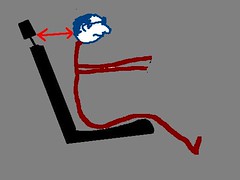
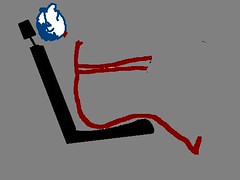
Figs 1 and 2: Whiplash injury, U.S. carseat/headrest design.
If I had to guess, I'd say it's not labor costs -- which are undoubtedly comparable in Europe if not Japan. It can't be inferior engineering ability. It's not the trial lawyers. The profusion of airbags come standard in the VW models under $20 K would have kept them quiet.
Could it be the same marketing phenomenon that I believe also explains Americans' attitude to air travel and health care? Basically, it's extremely important to Americans that having more money to spend should translate into marked improvements in the quality of life. Therefore, there has to be a wide gulf between first class and coach.
So it's important to the marketing departments of U.S. automakers to keep mid-level and economy cars crappy so that luxury cars will seem that much better. Just a theory.
The front seats seem flimsy, as if their moving parts have worked loose and will dislodge in an impact. And U.S. car manufacturers have somehow never gotten the concept of headrests. Long after European and Japanese car makers were producing contoured front seats with headrests that would actually support your head in a comfortable seated position, American car makers in the 1970s and 1980s were grudgingly putting these little upholstered tumors atop the front seats. Even as they've installed larger and better headrests in more recent years, they seem to have continued the tradition of designing seats to maximize your chances of a whiplash injury.


Figs 1 and 2: Whiplash injury, U.S. carseat/headrest design.
If I had to guess, I'd say it's not labor costs -- which are undoubtedly comparable in Europe if not Japan. It can't be inferior engineering ability. It's not the trial lawyers. The profusion of airbags come standard in the VW models under $20 K would have kept them quiet.
Could it be the same marketing phenomenon that I believe also explains Americans' attitude to air travel and health care? Basically, it's extremely important to Americans that having more money to spend should translate into marked improvements in the quality of life. Therefore, there has to be a wide gulf between first class and coach.
So it's important to the marketing departments of U.S. automakers to keep mid-level and economy cars crappy so that luxury cars will seem that much better. Just a theory.
Somebody up there is listening to me
The day after I said they should do it, the Mets signed David Wright to a 6-year deal with an option on a 7th year. He'll be 30 at the end of the contract. Long term contracts are not the norm in MLB for players in their early, arbitration-eligible years. Boy was that smart.
Sunday, August 06, 2006
Celebrity sighting
It really comes as no surprise that I got zero comments on yesterday's post. The occasional post about baseball and my self-identification as a "Mets fan" are really not enough to generate much of a baseball readership. And the post was incredibly long.
But at least I have this satisfaction. You see, yesterday, while vacationing in LA, I ran into baseball writer and ESPN baseball analyst Peter Gammons on the bus. Gammons and I are acquainted through my friend Josh, who seems to be a key "degree of separation" between me and everyone I know. For instance, it was from an invitation from somebody I met through Josh that I wound up at the birthday party where I first met B, my wife.
Anyway, Gammons, looking cute and dressed down in a scrawny, plucked-chicken sort of way in white shorts, a T-shirt with holes, and white sneakers and gym socks, was on his way back from the Dodgers game. I asked him whether this getup was his way of traveling incognito, and told him I was impressed that he would ride the bus in LA. We bantered about the game.
Unfortunately, he and his friend got off the bus before I could wind the conversation around to what would, for me, have been too good to be true. "So, Peter, how about I send you this blog post about the Whale Curve? It's just this baseball idea I have -- I just thought you might find it interesting." Still, I feel like I can just email it to him without awkwardness on the strength of our chance encounter.
I'd really like to do some travel posts about LA, which was looking incredibly beautiful as a result of some flower festival they happen to be hosting. The streets were festooned in a riot of color, and I couldn't believe that I didn't whip my camera out of my backpack.
The fact is that I wasn't on a bus in LA yesterday, wasn't even in LA and I don't think there's a flower festival going on there. I didn't meet Peter Gammons on the bus, and in fact have never met him. Nor did I first meet B through a friend of Josh. I do have a friend named Josh, a wife named B, a camera in my backpack, and there is a city called LA. The rest was a dream.
But the bizarre thing is this. I wrote out the foregoing blog post about running into Peter Gammons, in my head, during the dream. I'm pretty sure this is the first time I've dreamed about blogging.
What do we make of that?
But at least I have this satisfaction. You see, yesterday, while vacationing in LA, I ran into baseball writer and ESPN baseball analyst Peter Gammons on the bus. Gammons and I are acquainted through my friend Josh, who seems to be a key "degree of separation" between me and everyone I know. For instance, it was from an invitation from somebody I met through Josh that I wound up at the birthday party where I first met B, my wife.
Anyway, Gammons, looking cute and dressed down in a scrawny, plucked-chicken sort of way in white shorts, a T-shirt with holes, and white sneakers and gym socks, was on his way back from the Dodgers game. I asked him whether this getup was his way of traveling incognito, and told him I was impressed that he would ride the bus in LA. We bantered about the game.
Unfortunately, he and his friend got off the bus before I could wind the conversation around to what would, for me, have been too good to be true. "So, Peter, how about I send you this blog post about the Whale Curve? It's just this baseball idea I have -- I just thought you might find it interesting." Still, I feel like I can just email it to him without awkwardness on the strength of our chance encounter.
I'd really like to do some travel posts about LA, which was looking incredibly beautiful as a result of some flower festival they happen to be hosting. The streets were festooned in a riot of color, and I couldn't believe that I didn't whip my camera out of my backpack.
The fact is that I wasn't on a bus in LA yesterday, wasn't even in LA and I don't think there's a flower festival going on there. I didn't meet Peter Gammons on the bus, and in fact have never met him. Nor did I first meet B through a friend of Josh. I do have a friend named Josh, a wife named B, a camera in my backpack, and there is a city called LA. The rest was a dream.
But the bizarre thing is this. I wrote out the foregoing blog post about running into Peter Gammons, in my head, during the dream. I'm pretty sure this is the first time I've dreamed about blogging.
What do we make of that?
Saturday, August 05, 2006
The Whale Curve -- a baseball insight
The Mets just "locked up" Jose Reyes for the next few years, signing him to a 4-year deal -- at a bargain price of $6 million a year -- with an option for a fifth. So he's locked up through age 28. They should do the same thing with David Wright -- particularly with David Wright -- and should consider "locking him up" through age 31 or 32, and then trading him.
There’s a pattern in the careers of major league hitters that seems to hold true in a remarkable number of instances. It doesn’t describe the career of every major league hitter, but it probably describes the careers of the majority of position players good enough to play for more than 10 full major league seasons. (It doesn't, as far as I can tell, apply to pitchers.)
I call it “the Whale Curve.”
Essentially, if you graph a major league hitter’s year-by-year offensive production on the vertical axis and his age on the horizontal axis, you get a curve that resembles the outline of a whale.
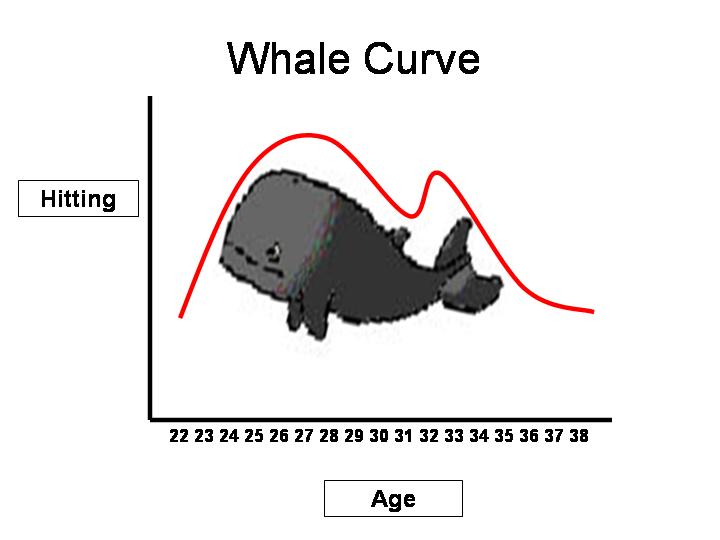
This reflects the following apparent facts: most major league hitters have their "career year" -- their best season -- at around age 27 or 28. (This is the top of the whale's head.) They then experience 2-3 seasons of decline from that peak, followed by a second, usually slightly lower peak (the whale’s tail), at around age 31 or 32. After that, age causes a general and more pronounced and permanent decline.
If you were to examine the career statistics of 20 randomly selected players with 10 or more years of major league experience, I bet you would find the Whale Curve in at least 12 (60%) of them.
I did a very unsystematic survey of 30 ballplayers and found the pattern in about 16-18 instances. It's hard to be precise, because identifying and ranking a player's 2-3 best offensive seasons can require some arguable judgment calls. In many cases, I just reviewed career stats (handily correlated by age at Baseballreference.com) and impressionistically picked out the best years.
A neater way to undertake the analysis would be to use Bill James's "win shares," in which he reduces the impact of a players entire package of offensive statistics to a single integer. This makes comparisons of a players' seasons quite easy, but since I don't have the Win Shares book, I was forced to rely on the non-random selection of players whose Win Shares data James chose to present in the appendix to his revised Historical Baseball Abstract.
Here are some results:
Fitting the pattern very closely, with the best season at 27 or 28 and the second best season 3-4 years later, at 31 or 32, are: Dave Winfield, Barry Larkin, Lenny Dykstra, Jeff Bagwell, Manny Ramirez, Mike Piazza, Carlos Delgado, and Frank Thomas. Dave Parker and Ken Griffey, Jr. both had career years at 27 or 28 and then had their "whale tail" (their later career spike) at 34-35 -- though, notably, both had seriously limited playing between ages 30 and 33 due to injuries.
There are minor variants that are still fundamentally captured by this curve. A handful of players fit the pattern, except with the head and tail reversed -- that is, the second career spike was slightly better than the earlier one: Gary Carter, Ricky Henderson, George Brett. Jeff Bagwell put two "whale tail" peak seasons together at age 31-32. Sometimes the "whale tail" is the 3rd best of the player's career, with the second best coming one year before or after the first"career" season.
And the whale shape is a very rough approximation. Some players' peaks will be less pronounced -- less different from their down years. And career trajectory curves are not always so rounded -- Lenny Dykstra's peak years form a curve looking more like a suspension bridge than a whale -- but you have to admit the pattern is remarkably counterintuitive. You probably expected that career trajectories would either have no discernable pattern at all, or else would look more like a bell curve, with the top being at somewhere around 28 or 29. But it doesn't work that way in most cases.
If I'm right about this, why is there a Whale Curve? My theory is that hitting performance is the result of a relationship between two curves: raw physical skill and major league experience and savvy. Many baseball experts have noted that major league hitters reach their physical peak at around age 28. My theory is that after hitting that peak, most players' physical skills drop off markedly, causing the decline (and forming the whale-head shape of the curve).
What causes the tail -- the second performance peak -- is the rise of baseball experience and savvy, that allows hitters to put together a second "career year" before their physical skills deteriorate to the point that savvy can no longer compensate. The dip between head and tail is the result either of insufficient baseball savvy, or unpreparedness or unwillingness to recognize one's declining physical skills and the need to compensate for them with strategems.
Is this "Whale Curve" idea original? I don't know. Certainly, the notion of a "career year" is commonplace, as is the idea of a performance peak at around age 28. What I've never heard before is any systematic observation of, let alone explanation for, the whale tail -- the second, lesser peak. That tends to get treated either as consisency or else a kind of comeback miracle. Anyway, let me know if you've heard this notion before.
Last season, the Mets' Cliff Floyd was having a renaissance year after several years of injury and decling performance following his "career year" -- at age 28. When the Mets were clearly out of it in July, I had argued to friends that now would be the time to trade him. He was 32 and enjoying his second career peak season -- a classic Whale Curve career trajectory. His trade value, I argued, would never be higher. They kept him. I don't mind, because I think he's a great "clubhouse influence" and still has some pop in his bat. But his offensive production has dropped off markedly -- and predictably -- this season.
You can see how this might be useful to general managers (and fantasy league managers). Whether you use the Whale Curve to guide your trading strategy or not, it can help for planning purposes. You would have been ill advised to pencil in Cliff Floyd for more than 24 home runs this season (compared to last year's 32). Carlos Delgado peaked at 28 and 31, but then had a surprising comeback last year at 33. While a two-peaked tail doesn't fit my model, you'd nevertheless be crazy not to expect a significant dropoff in production from Delgado at 34. Delgado, by the way, has been in a two month seeming slump since mid June. I'd love to be wrong about this and see him finish up strong, but I'm afraid it's not a slump -- he's a streak hitter who's just getting old.*
What about all the players -- the 40% or so -- that don't fit the pattern? Don't they significantly diminish the usefulness of the "Whale Curve"? To be sure, there are some outliers that I just can't explain, who find baseball inspiration in their 30s and recreate themselves -- Paul Molitor, Tony Gwynn, Craig Biggio. Derek Jeter is the poster boy for "outlier." And there are surprising flameouts, like Will Clark, who peaked at 25 and 27 and was washed up by 31 without ever peaking again.
But most of the exceptions to the whale curve seem themselves to fall into patterns that can be explained consistently with the whale curve ideas.
1. Bulking up. Players who have their best seasons at age 33 or later, after several years as full time major leaguers, have probably undertaken a major campaign to bulk up their bodies. Interestingly, both Barry Bonds and Rafael Palmiero had "Whale Curve" career trajectories -- best season at 28, second best season at 31, followed by a marked decline. Both "miraculously" broke out of this pattern in their mid-late 30s, Palmiero at 34 and Bonds at 35. Bulking up with supplements, whether illegal steroids or legal stuff, is undertaken precisely to offset the body's natural decline and probably always (certainly in the case of steroids) comes at the price of long term health consequences. I think the a player whose career path breaks the Whale Curve pattern in this way -- having a resurgence of home-run power after age 33 -- has gone on some bulk-up regimen. Makes you wonder what Jim Thome is up to. Players like Jason Giambi or Jose Canseco, who bulked up on steroids from the outset of their careers, were never going to have Whale Curve trajectories. Canseco flamed out; Giambi is up and down.
2. Age at promotion to the majors. The Whale Curve is more likely to be descriptive of players who became major league regulars between 21-24. Players who break into the majors after 24 will be relative newcomers when they hit their physical peak, thereby throwing off the phyisical prime-plus-playing experience algorithm that produces the Whale Curve. Players who become major league regulars before age 21 -- A-Rod, or Andruw Jones, for example -- also throw off the algorithm. They become seasoned veterans at around the same time they hit their physical peak. There's a tendency in these cases to have three peaks, like Willie Mays, one of them at 23-24 -- maybe there's some significance to three years of MLB experience -- or perhaps more of a bell curve career path.
3. Exogenous factors. Physical age and experience seem to be huge determinants of a player's relative year-to-year performance. But there are other factors external to these physical or mental abilities that can dominate. Injuries are the most obvious example. Harder-to-detect factors that would disrupt the Whale Curve are external changes to the hitting environment -- for example, a move from a hitters to a pitchers home ballpark (e.g., Hank Aaron), a significant change in the strike zone, introduce a lively ball, lowering the pitchers' mound, etc. Or pure playing time can throw off the curve: a player used as a sub or platoon player until age 30 who then finds himself playing every day may have his first peak year in his 30s.
Getting back to Reyes and Wright. Reyes, who became a major league regular at 20, is less likely that average to have a Whale Curve career path. But Wright, who's slightly older and started later, was pushing 22 when he became a regular. Look for him to peak at 28 (wow!!) and again at 31 or 32. And manage his contract accordingly.
_____
The season is exactly 2/3 over today, and Carlos has 26 homers and 73 RBIs. Projecting that performance out proportionally through the final third of the season, you might expect him to finish with 39 homers and 109 RBIs. Belive me, I wish that would happen. But I'm expecting he'll put up another 6-7 homers and will not break 100 RBIs.
There’s a pattern in the careers of major league hitters that seems to hold true in a remarkable number of instances. It doesn’t describe the career of every major league hitter, but it probably describes the careers of the majority of position players good enough to play for more than 10 full major league seasons. (It doesn't, as far as I can tell, apply to pitchers.)
I call it “the Whale Curve.”
Essentially, if you graph a major league hitter’s year-by-year offensive production on the vertical axis and his age on the horizontal axis, you get a curve that resembles the outline of a whale.

This reflects the following apparent facts: most major league hitters have their "career year" -- their best season -- at around age 27 or 28. (This is the top of the whale's head.) They then experience 2-3 seasons of decline from that peak, followed by a second, usually slightly lower peak (the whale’s tail), at around age 31 or 32. After that, age causes a general and more pronounced and permanent decline.
If you were to examine the career statistics of 20 randomly selected players with 10 or more years of major league experience, I bet you would find the Whale Curve in at least 12 (60%) of them.
I did a very unsystematic survey of 30 ballplayers and found the pattern in about 16-18 instances. It's hard to be precise, because identifying and ranking a player's 2-3 best offensive seasons can require some arguable judgment calls. In many cases, I just reviewed career stats (handily correlated by age at Baseballreference.com) and impressionistically picked out the best years.
A neater way to undertake the analysis would be to use Bill James's "win shares," in which he reduces the impact of a players entire package of offensive statistics to a single integer. This makes comparisons of a players' seasons quite easy, but since I don't have the Win Shares book, I was forced to rely on the non-random selection of players whose Win Shares data James chose to present in the appendix to his revised Historical Baseball Abstract.
Here are some results:
Fitting the pattern very closely, with the best season at 27 or 28 and the second best season 3-4 years later, at 31 or 32, are: Dave Winfield, Barry Larkin, Lenny Dykstra, Jeff Bagwell, Manny Ramirez, Mike Piazza, Carlos Delgado, and Frank Thomas. Dave Parker and Ken Griffey, Jr. both had career years at 27 or 28 and then had their "whale tail" (their later career spike) at 34-35 -- though, notably, both had seriously limited playing between ages 30 and 33 due to injuries.
There are minor variants that are still fundamentally captured by this curve. A handful of players fit the pattern, except with the head and tail reversed -- that is, the second career spike was slightly better than the earlier one: Gary Carter, Ricky Henderson, George Brett. Jeff Bagwell put two "whale tail" peak seasons together at age 31-32. Sometimes the "whale tail" is the 3rd best of the player's career, with the second best coming one year before or after the first"career" season.
And the whale shape is a very rough approximation. Some players' peaks will be less pronounced -- less different from their down years. And career trajectory curves are not always so rounded -- Lenny Dykstra's peak years form a curve looking more like a suspension bridge than a whale -- but you have to admit the pattern is remarkably counterintuitive. You probably expected that career trajectories would either have no discernable pattern at all, or else would look more like a bell curve, with the top being at somewhere around 28 or 29. But it doesn't work that way in most cases.
If I'm right about this, why is there a Whale Curve? My theory is that hitting performance is the result of a relationship between two curves: raw physical skill and major league experience and savvy. Many baseball experts have noted that major league hitters reach their physical peak at around age 28. My theory is that after hitting that peak, most players' physical skills drop off markedly, causing the decline (and forming the whale-head shape of the curve).
What causes the tail -- the second performance peak -- is the rise of baseball experience and savvy, that allows hitters to put together a second "career year" before their physical skills deteriorate to the point that savvy can no longer compensate. The dip between head and tail is the result either of insufficient baseball savvy, or unpreparedness or unwillingness to recognize one's declining physical skills and the need to compensate for them with strategems.
Is this "Whale Curve" idea original? I don't know. Certainly, the notion of a "career year" is commonplace, as is the idea of a performance peak at around age 28. What I've never heard before is any systematic observation of, let alone explanation for, the whale tail -- the second, lesser peak. That tends to get treated either as consisency or else a kind of comeback miracle. Anyway, let me know if you've heard this notion before.
Last season, the Mets' Cliff Floyd was having a renaissance year after several years of injury and decling performance following his "career year" -- at age 28. When the Mets were clearly out of it in July, I had argued to friends that now would be the time to trade him. He was 32 and enjoying his second career peak season -- a classic Whale Curve career trajectory. His trade value, I argued, would never be higher. They kept him. I don't mind, because I think he's a great "clubhouse influence" and still has some pop in his bat. But his offensive production has dropped off markedly -- and predictably -- this season.
You can see how this might be useful to general managers (and fantasy league managers). Whether you use the Whale Curve to guide your trading strategy or not, it can help for planning purposes. You would have been ill advised to pencil in Cliff Floyd for more than 24 home runs this season (compared to last year's 32). Carlos Delgado peaked at 28 and 31, but then had a surprising comeback last year at 33. While a two-peaked tail doesn't fit my model, you'd nevertheless be crazy not to expect a significant dropoff in production from Delgado at 34. Delgado, by the way, has been in a two month seeming slump since mid June. I'd love to be wrong about this and see him finish up strong, but I'm afraid it's not a slump -- he's a streak hitter who's just getting old.*
What about all the players -- the 40% or so -- that don't fit the pattern? Don't they significantly diminish the usefulness of the "Whale Curve"? To be sure, there are some outliers that I just can't explain, who find baseball inspiration in their 30s and recreate themselves -- Paul Molitor, Tony Gwynn, Craig Biggio. Derek Jeter is the poster boy for "outlier." And there are surprising flameouts, like Will Clark, who peaked at 25 and 27 and was washed up by 31 without ever peaking again.
But most of the exceptions to the whale curve seem themselves to fall into patterns that can be explained consistently with the whale curve ideas.
1. Bulking up. Players who have their best seasons at age 33 or later, after several years as full time major leaguers, have probably undertaken a major campaign to bulk up their bodies. Interestingly, both Barry Bonds and Rafael Palmiero had "Whale Curve" career trajectories -- best season at 28, second best season at 31, followed by a marked decline. Both "miraculously" broke out of this pattern in their mid-late 30s, Palmiero at 34 and Bonds at 35. Bulking up with supplements, whether illegal steroids or legal stuff, is undertaken precisely to offset the body's natural decline and probably always (certainly in the case of steroids) comes at the price of long term health consequences. I think the a player whose career path breaks the Whale Curve pattern in this way -- having a resurgence of home-run power after age 33 -- has gone on some bulk-up regimen. Makes you wonder what Jim Thome is up to. Players like Jason Giambi or Jose Canseco, who bulked up on steroids from the outset of their careers, were never going to have Whale Curve trajectories. Canseco flamed out; Giambi is up and down.
2. Age at promotion to the majors. The Whale Curve is more likely to be descriptive of players who became major league regulars between 21-24. Players who break into the majors after 24 will be relative newcomers when they hit their physical peak, thereby throwing off the phyisical prime-plus-playing experience algorithm that produces the Whale Curve. Players who become major league regulars before age 21 -- A-Rod, or Andruw Jones, for example -- also throw off the algorithm. They become seasoned veterans at around the same time they hit their physical peak. There's a tendency in these cases to have three peaks, like Willie Mays, one of them at 23-24 -- maybe there's some significance to three years of MLB experience -- or perhaps more of a bell curve career path.
3. Exogenous factors. Physical age and experience seem to be huge determinants of a player's relative year-to-year performance. But there are other factors external to these physical or mental abilities that can dominate. Injuries are the most obvious example. Harder-to-detect factors that would disrupt the Whale Curve are external changes to the hitting environment -- for example, a move from a hitters to a pitchers home ballpark (e.g., Hank Aaron), a significant change in the strike zone, introduce a lively ball, lowering the pitchers' mound, etc. Or pure playing time can throw off the curve: a player used as a sub or platoon player until age 30 who then finds himself playing every day may have his first peak year in his 30s.
Getting back to Reyes and Wright. Reyes, who became a major league regular at 20, is less likely that average to have a Whale Curve career path. But Wright, who's slightly older and started later, was pushing 22 when he became a regular. Look for him to peak at 28 (wow!!) and again at 31 or 32. And manage his contract accordingly.
_____
The season is exactly 2/3 over today, and Carlos has 26 homers and 73 RBIs. Projecting that performance out proportionally through the final third of the season, you might expect him to finish with 39 homers and 109 RBIs. Belive me, I wish that would happen. But I'm expecting he'll put up another 6-7 homers and will not break 100 RBIs.
Friday, August 04, 2006
Existential Friday: Woody Allen
In the life and work of Woody Allen, every day is existential Friday, is it not?
I saw Scoop, Woody Allen's latest, last week. But my review of it and of his movies in general has gotten so long-winded, that I have to break it up into a few separate posts. For now, let's just do a whirlwind tour of his career.
Woody Allen has directed 42 major motion pictures, an incredible acheivement in this era of movie-making.
I saw 7 of Allen's first 8 movies. (The only one I missed is a made for TV comedy I'd never heard of, called Men of Crisis: the Harvey Wallinger Story.) In the past 20 years, I've started to skip more of them -- particularly the not-comedies -- so that I've seen 31 of his 42 movies overall.
I think he's made several good movies, but, frankly, no great ones. Annie Hall -- probably the movie that gets the most votes for Allen's best -- seems so dated and amateurish to me now. What I still love, or like, about Annie Hall are certain classic bits -- particularly, the split screen comparison of dinner scenes in a Jewish and a Wasp household.
And that's really his style, with comedy. He throws lots of jokes at you, and some are classic. The rest are formulaic and get you to laugh mechanically or just fall flat.
In a sense, that's been his style with filmmaking too. He's a genius, not because he has given us an incomparable flash of inspiration, but because he's so productive and hardworking. He produces about one movie every year -- apparently he prides himself on that regularity. To turn out one movie a year that is more or less watchable -- a movie written and directed by himself -- is in my a kind of genius, of the sort that is "90% perspiration."
Genius or not, as of this writing, there are "only" nine Woody Allen movies I like, in the sense that I enjoyed them before and wouldn't mind seeing them again. Only one is from before 1980.
The next list is movies that I liked when I saw them, but that have worn thin on me. I find them teeth-grindingly dated and stilted now -- even though each one of them have one or more classic and timeless comedic bits.
What about you?
I saw Scoop, Woody Allen's latest, last week. But my review of it and of his movies in general has gotten so long-winded, that I have to break it up into a few separate posts. For now, let's just do a whirlwind tour of his career.
Woody Allen has directed 42 major motion pictures, an incredible acheivement in this era of movie-making.
I saw 7 of Allen's first 8 movies. (The only one I missed is a made for TV comedy I'd never heard of, called Men of Crisis: the Harvey Wallinger Story.) In the past 20 years, I've started to skip more of them -- particularly the not-comedies -- so that I've seen 31 of his 42 movies overall.
I think he's made several good movies, but, frankly, no great ones. Annie Hall -- probably the movie that gets the most votes for Allen's best -- seems so dated and amateurish to me now. What I still love, or like, about Annie Hall are certain classic bits -- particularly, the split screen comparison of dinner scenes in a Jewish and a Wasp household.
And that's really his style, with comedy. He throws lots of jokes at you, and some are classic. The rest are formulaic and get you to laugh mechanically or just fall flat.
In a sense, that's been his style with filmmaking too. He's a genius, not because he has given us an incomparable flash of inspiration, but because he's so productive and hardworking. He produces about one movie every year -- apparently he prides himself on that regularity. To turn out one movie a year that is more or less watchable -- a movie written and directed by himself -- is in my a kind of genius, of the sort that is "90% perspiration."
Genius or not, as of this writing, there are "only" nine Woody Allen movies I like, in the sense that I enjoyed them before and wouldn't mind seeing them again. Only one is from before 1980.
Hollywood Ending (2002)
Small Time Crooks (2000)
Sweet and Lowdown (1999)
Manhattan Murder Mystery (1993)
Radio Days (1987)
The Purple Rose of Cairo (1985)
Broadway Danny Rose (1984)
Zelig (1983)
Take the Money and Run (1969)
The next list is movies that I liked when I saw them, but that have worn thin on me. I find them teeth-grindingly dated and stilted now -- even though each one of them have one or more classic and timeless comedic bits.
Manhattan (1979)
Annie Hall (1977)
Love and Death (1975)
Sleeper (1973)
Everything You Always Wanted to Know About Sex * But Were Afraid to Ask (1972)
Bananas (1971)
What about you?
Thursday, August 03, 2006
A gas in Gastown
[residual travel-blogging: Vancouver BC, June 13, 2006]
Downtown Vancouver is on a peninsula. A large sound marks its northern boundary, while the southern edge is rimmed by a smaller inlet modestly named "False Creek." Cute pontoon boats called "Aquabuses" ferry you across False Creek to Granville Island and the Granville Island Market, an excellent imitation of Seattle's Pike Place Market.
Vancouver is striking for its profusion of glassy high-rise residential buildings. While I have mixed feelings about these buildings aesthetically, and wonder about the wisdom of so much overhead glass in an earthquake-prone region, I concede that building upward is often to be preferred over sprawling outward for residential development.
Vancouver has a welcoming, easy-going, live-and-let-live vibe. Even its skid row is kinda nice, at least relative to its counterparts in U.S. cities.
We stumbled on this part of town on a pleasant evening stroll though the city. We had just walked through "Gastown," a renovated touristy area filled with tourist restaurants and gift shops with "I {heart} Canada" T-shirts. At the edge of Gastown, we wandered into the sports bar where we joined the locals in rooting for the Edmonton Oilers against the Carolina Hurricanes for a period.
Leaving the bar in the direction of Chinatown, I curiously noted a young college-student-looking man sitting on a stoop lighting up a glass pipe with a cigarette lighter.
We reached the corner, and crossing the street, another guy looked at us and said, "Hey, there's a building on fire back threre behind you!"
Is everybody here on drugs? I wondered. But when we reached the corner and looked back, sure enough there was a building on fire.
My hope to return to the friendly confines of a crowded tourist area was dashed when it turned out that the streets of neighboring Chinatown were totally deserted. We ended up walking through the semi-deserted fairgrounds from the 1986 World's Fair, past the empty sports arena, under a web of highway overpasses, and finally, back to the comfort of Yaletown, the trendy, busy restaurant section built out of an old warehouse district. Pretty mild stuff compared to what you might encounter getting lost in a big American city.
View of North Vancouver across the Burrard Inlet.
Vancouver is a delightful city. It has a compact, walkable downtown area, surrounded by sprawling extensions set amid breathtaking fjord-like thingies. (See downtown and area maps.) I'm sure there's a word for oceanic inlets or "sounds" with green hills rising out of them rimmed by snow capped mountains. I just don't know the word.View from our room in the Sheraton.
Downtown Vancouver is on a peninsula. A large sound marks its northern boundary, while the southern edge is rimmed by a smaller inlet modestly named "False Creek." Cute pontoon boats called "Aquabuses" ferry you across False Creek to Granville Island and the Granville Island Market, an excellent imitation of Seattle's Pike Place Market.
Vancouver is striking for its profusion of glassy high-rise residential buildings. While I have mixed feelings about these buildings aesthetically, and wonder about the wisdom of so much overhead glass in an earthquake-prone region, I concede that building upward is often to be preferred over sprawling outward for residential development.
Above and below: downtown skyline from False Creek.
Vancouver has a welcoming, easy-going, live-and-let-live vibe. Even its skid row is kinda nice, at least relative to its counterparts in U.S. cities.
We stumbled on this part of town on a pleasant evening stroll though the city. We had just walked through "Gastown," a renovated touristy area filled with tourist restaurants and gift shops with "I {heart} Canada" T-shirts. At the edge of Gastown, we wandered into the sports bar where we joined the locals in rooting for the Edmonton Oilers against the Carolina Hurricanes for a period.
Tourist shop selling Royal Canadian Mounted Police licensed goods.
Everyone needs a Mounties T-shirt.
Everyone needs a Mounties T-shirt.
Leaving the bar in the direction of Chinatown, I curiously noted a young college-student-looking man sitting on a stoop lighting up a glass pipe with a cigarette lighter.
"Do they decriminalize marijuana here in Canada?" I said to B.Before I could argue the point, my eye was caught by a thin man with a gray beard stumbling out of an alley. At the edge of the alley, a few feet from the sidewalk, a young couple sat on the ground brandishing a long, thin rubber tube of the kind used as a tourniquet by the nurse who takes your blood sample and, of course, intravenous drug users. The inquisitive part of my brain wanted to confirm this by looking for the hypodermic needle, but my socially conscious side thought "it's not polite to stare." Meanwhile, my motor functions caused my feet to walk faster.
"Maybe," she replied, "but I'm pretty sure that was a crack pipe."
We reached the corner, and crossing the street, another guy looked at us and said, "Hey, there's a building on fire back threre behind you!"
Is everybody here on drugs? I wondered. But when we reached the corner and looked back, sure enough there was a building on fire.
The edge of Gastown. But for the buring building,
one of the nicest drug neighborhoods you'll ever see.
one of the nicest drug neighborhoods you'll ever see.
My hope to return to the friendly confines of a crowded tourist area was dashed when it turned out that the streets of neighboring Chinatown were totally deserted. We ended up walking through the semi-deserted fairgrounds from the 1986 World's Fair, past the empty sports arena, under a web of highway overpasses, and finally, back to the comfort of Yaletown, the trendy, busy restaurant section built out of an old warehouse district. Pretty mild stuff compared to what you might encounter getting lost in a big American city.
Under construction: the main media venue for the 2010 Winter Olympics.
Vancouver has miles of waterfront. Above: the Cruise Ship Terminal, Burrard Inlet.
Crying out for redevelopment: this semi-deserted remnant
of the 1986 World's Fair houses a low-traffic night club and casino.
of the 1986 World's Fair houses a low-traffic night club and casino.
Yaletown. Naturally, I gravitated toward this neighborhood.
Wednesday, August 02, 2006
A good name for a coffee house
The new barista at Grandma Moses is reading The Prince between customers. Not for a course, she says -- just for fun! (Maybe she plans to push out the owners.)
How about Machiavelli as a name for a coffee house? Sounds like a fancy espresso drink, no?
How about Machiavelli as a name for a coffee house? Sounds like a fancy espresso drink, no?
Tuesday, August 01, 2006
Canadian English -- seeing the signs
[more residual travel blogging]
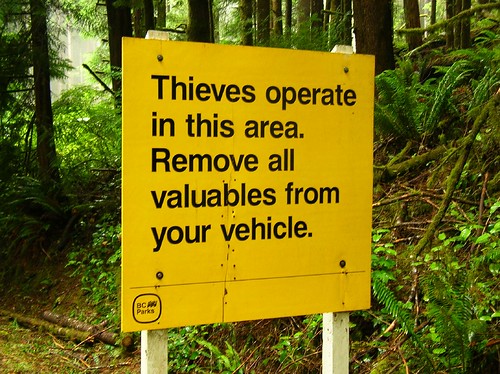
It must be both a blessing and a curse to be Canada, living obscurely in the giant shadow cast by the USA. The blessings are those of peaceful, quiet, sensible existence, except of course when it comes to ice hockey. The curse is the annoyance of having your culture overlooked.
Brits and Americans love to compare notes on the differences between "English" and "American English," and will even stop to make fun of Australian accents or hire Crocodile Dundee to advertize a sports utility vehicle. But whoever talks about "Canadian English."
Yet not only do Canadians speak fluent English -- I can attest personally to that -- but they also have such cute little ways with their version of our language. What I find particularly charming about Canadian English is their not-quite-Britishisms -- as if they were trying to remind everyone that they never rebelled and exited the British Commonwealth.
Take the warning sign, at the top of this post. In the US, the equivalent warning would say: "Warning: Do Not Leave Valuables in Your Car." It's a blunt message of fear. But the Canadian message suggests an enlighted culture that acknowledges that thieves are people too -- people who, indeed, apply some skill in their craft. They don't just steal your stuff -- they "operate."
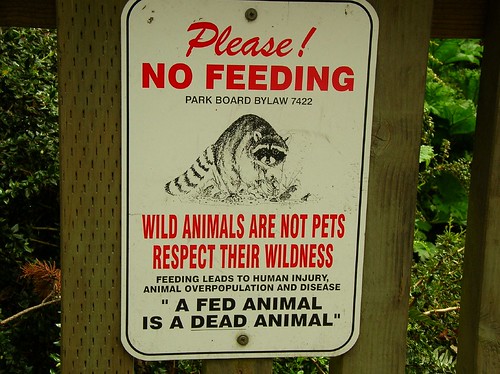
The Canadian version of "Please Do Not Feed Wildlife" is noteworthy for its effort to reach people with a diversity of communicative styles. We get the curt general admonition, and a nice jingle at the end, with an explanation for people who need to be convinced with reasons. And I love the thought of such a restrained, polite people as the Canadians respecting "wildness" in others.
This next sign, I must admit, confuses me:
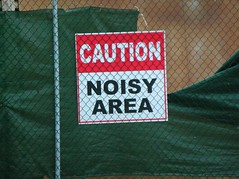
This was posted on the fence of a large construction excavation. Deceptively simple, no? When I was there in the evening, it was very quiet.
I've already discussed this one. I guess Canadians are just as intent as Americans on avoiding inappropriate behaviors:
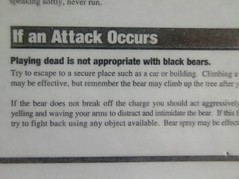
This next sign, at the entrance to the Vancouver Aquarium, continues with the animal protection theme. Yet it seems to signal more subtle things about Canadians than about the animals they wish to protect.
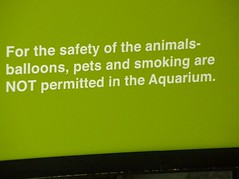
Like the Brits, Canadians have a penchant for names that exist in the U.S. only in anglophile children's literature:
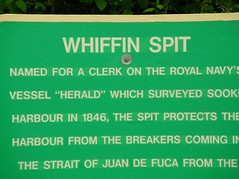
The Canadians are an unpretentious people. So much so, that on that rare occasion when they try to be pretentious, they can't quite pull it off. This next item is from the inside cover of a menu of a 5-star restaurant at an inn on Vancouver Island.
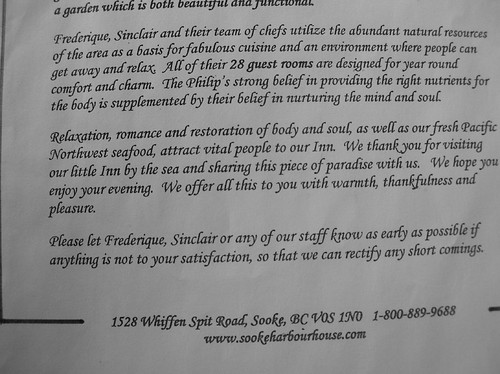
The first thing I'd like you to rectify, sir, is to make "shortcoming" one word.
Canadians' relationship to visual images is also subtly different from our own. These next images would appear in the United States on the cover of a cheap romance novel or a home pregnancy test kit:
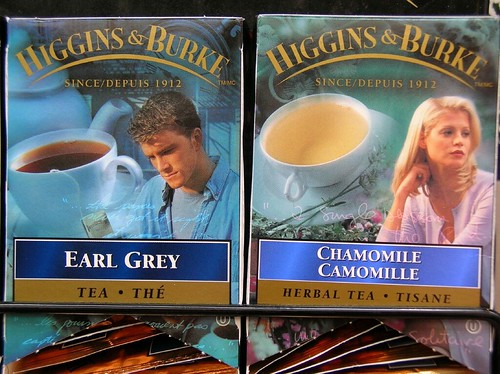
But something about them makes Canadians want to drink tea.
Don't get me started with the road signs. What would you do if you were driving and you suddenly saw this?
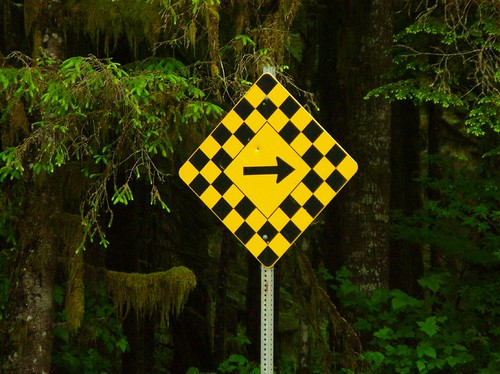

It must be both a blessing and a curse to be Canada, living obscurely in the giant shadow cast by the USA. The blessings are those of peaceful, quiet, sensible existence, except of course when it comes to ice hockey. The curse is the annoyance of having your culture overlooked.
Brits and Americans love to compare notes on the differences between "English" and "American English," and will even stop to make fun of Australian accents or hire Crocodile Dundee to advertize a sports utility vehicle. But whoever talks about "Canadian English."
Yet not only do Canadians speak fluent English -- I can attest personally to that -- but they also have such cute little ways with their version of our language. What I find particularly charming about Canadian English is their not-quite-Britishisms -- as if they were trying to remind everyone that they never rebelled and exited the British Commonwealth.
Take the warning sign, at the top of this post. In the US, the equivalent warning would say: "Warning: Do Not Leave Valuables in Your Car." It's a blunt message of fear. But the Canadian message suggests an enlighted culture that acknowledges that thieves are people too -- people who, indeed, apply some skill in their craft. They don't just steal your stuff -- they "operate."

The Canadian version of "Please Do Not Feed Wildlife" is noteworthy for its effort to reach people with a diversity of communicative styles. We get the curt general admonition, and a nice jingle at the end, with an explanation for people who need to be convinced with reasons. And I love the thought of such a restrained, polite people as the Canadians respecting "wildness" in others.
This next sign, I must admit, confuses me:

This was posted on the fence of a large construction excavation. Deceptively simple, no? When I was there in the evening, it was very quiet.
I've already discussed this one. I guess Canadians are just as intent as Americans on avoiding inappropriate behaviors:

This next sign, at the entrance to the Vancouver Aquarium, continues with the animal protection theme. Yet it seems to signal more subtle things about Canadians than about the animals they wish to protect.

Like the Brits, Canadians have a penchant for names that exist in the U.S. only in anglophile children's literature:

The Canadians are an unpretentious people. So much so, that on that rare occasion when they try to be pretentious, they can't quite pull it off. This next item is from the inside cover of a menu of a 5-star restaurant at an inn on Vancouver Island.

The first thing I'd like you to rectify, sir, is to make "shortcoming" one word.
Canadians' relationship to visual images is also subtly different from our own. These next images would appear in the United States on the cover of a cheap romance novel or a home pregnancy test kit:

But something about them makes Canadians want to drink tea.
Don't get me started with the road signs. What would you do if you were driving and you suddenly saw this?

Subscribe to Comments [Atom]

